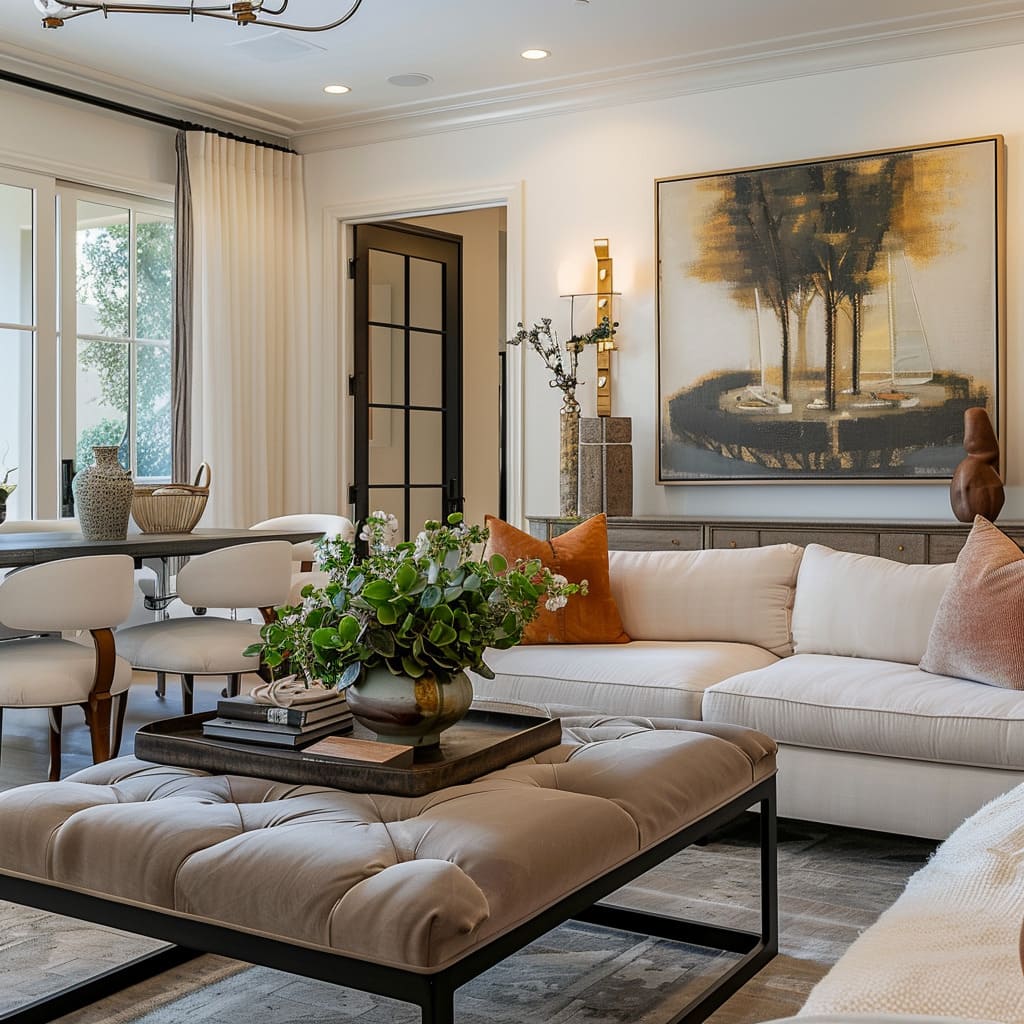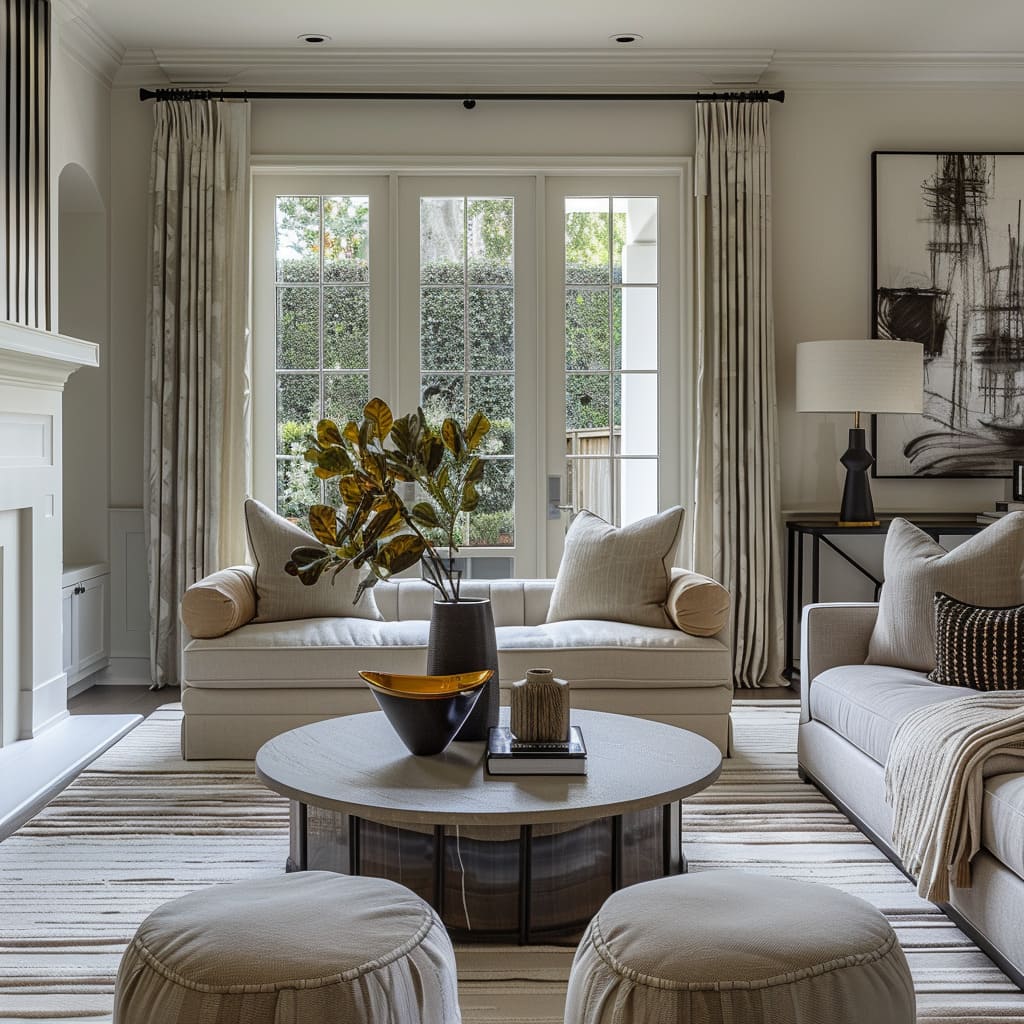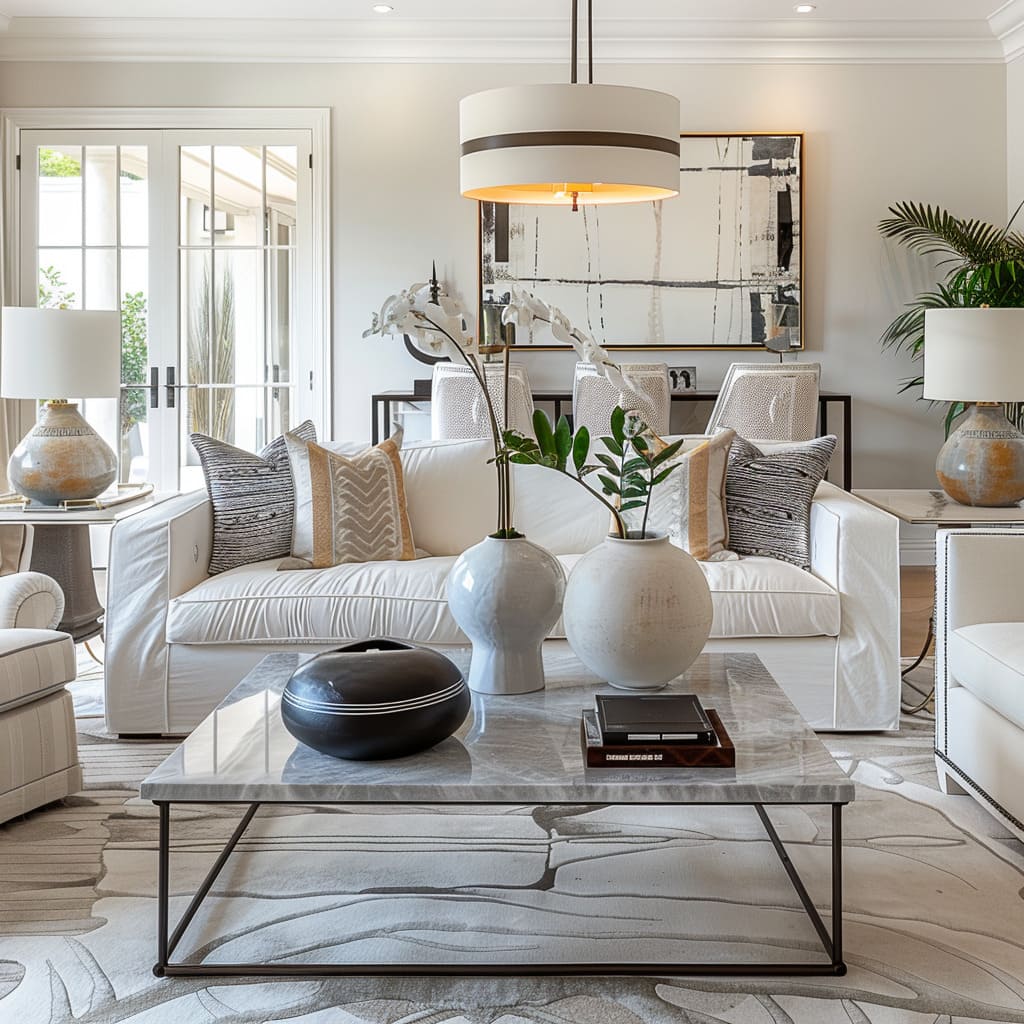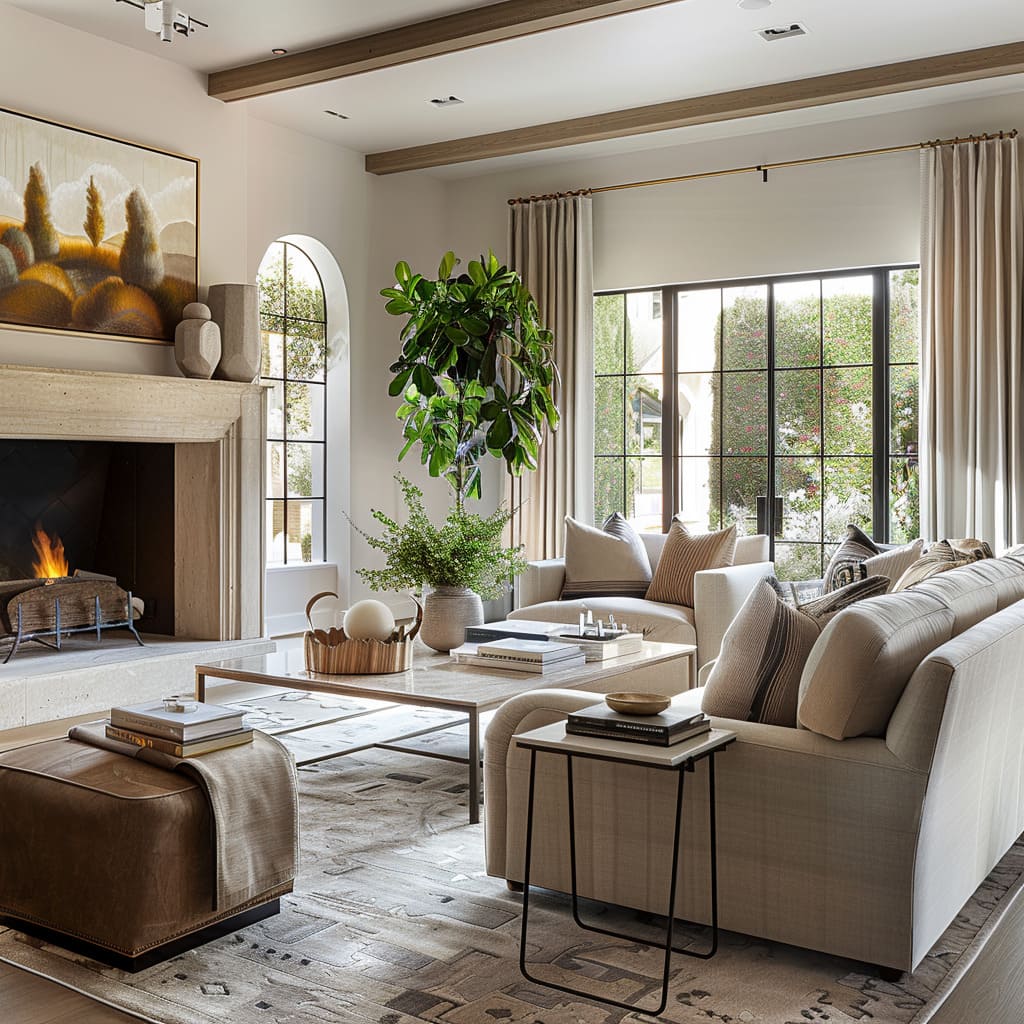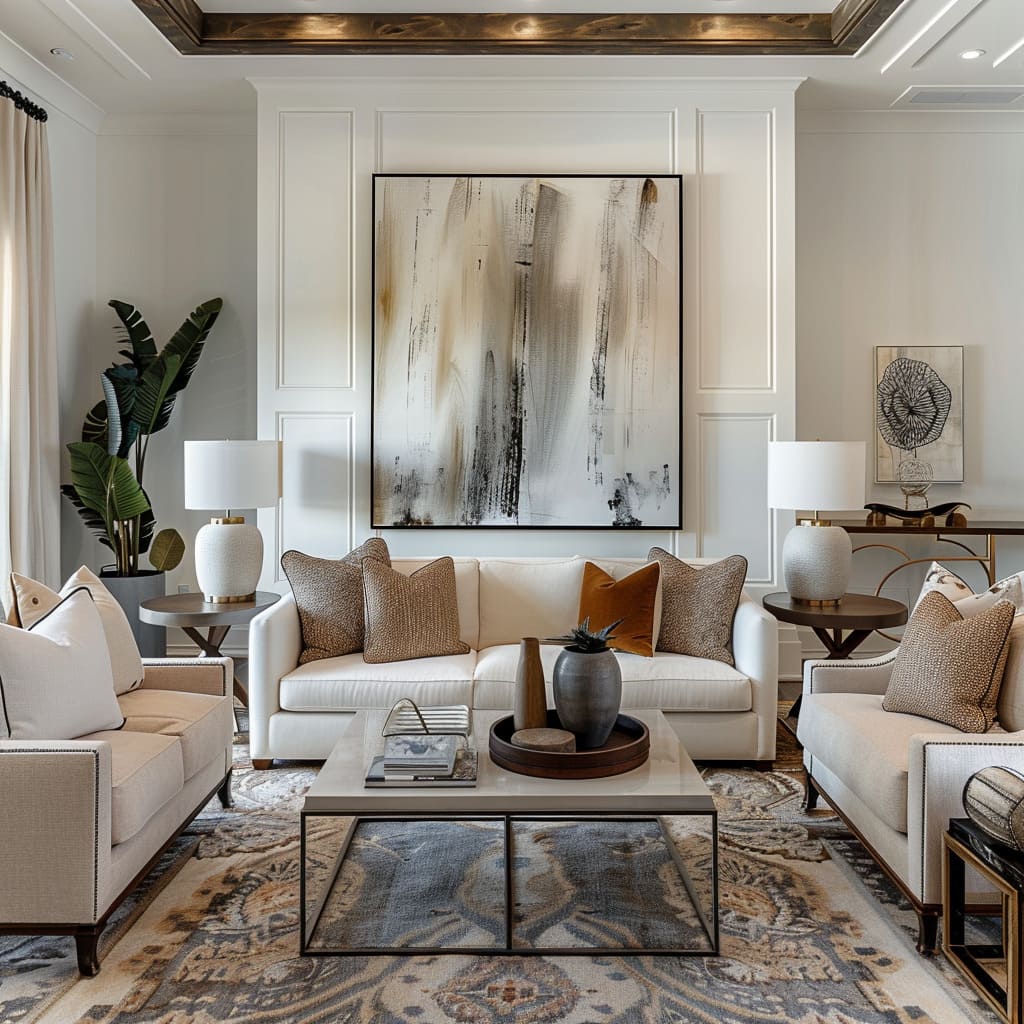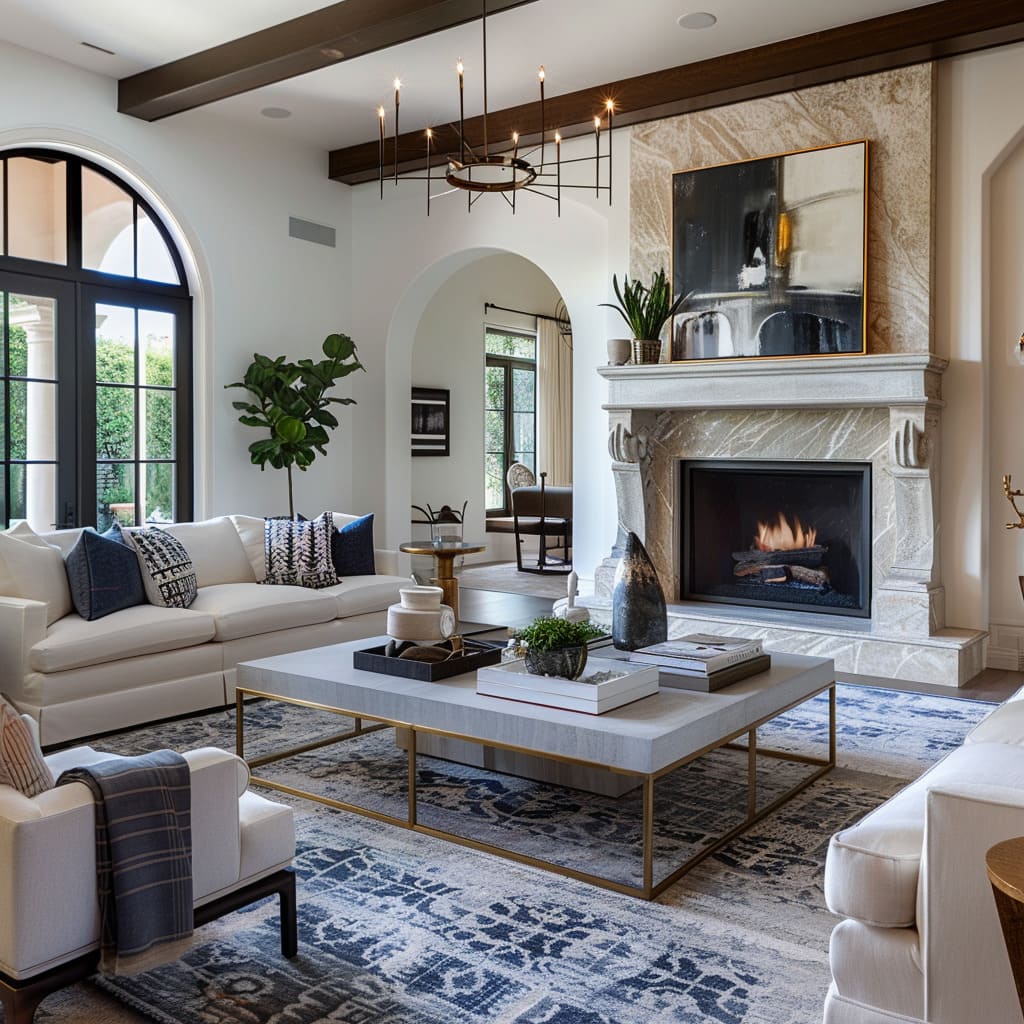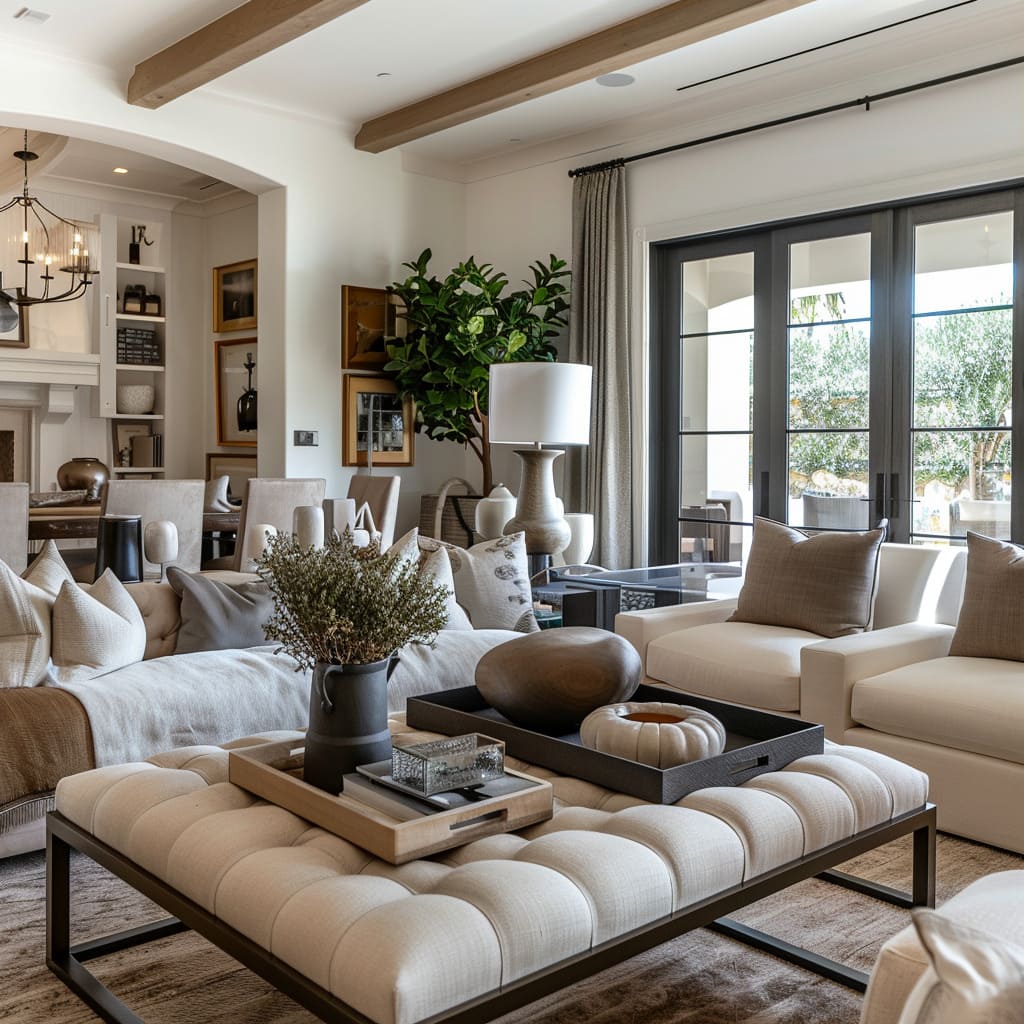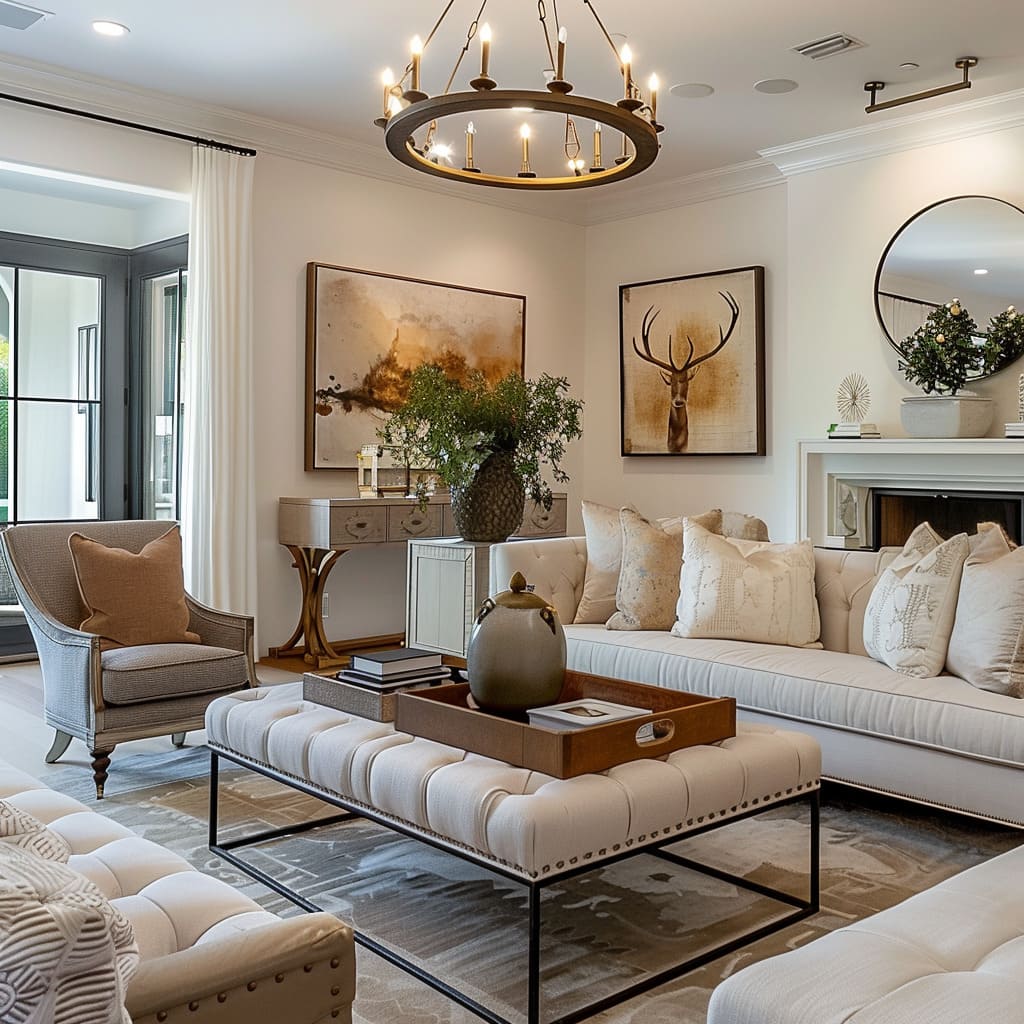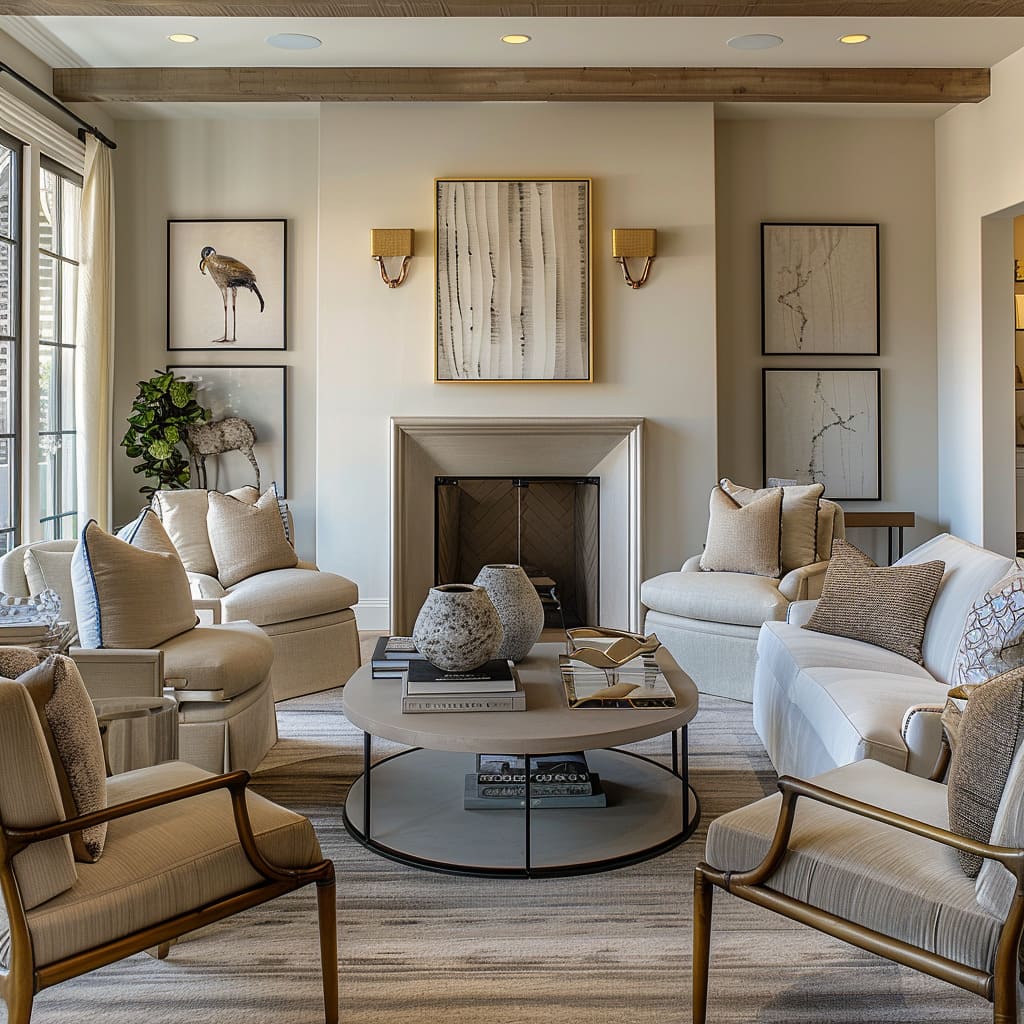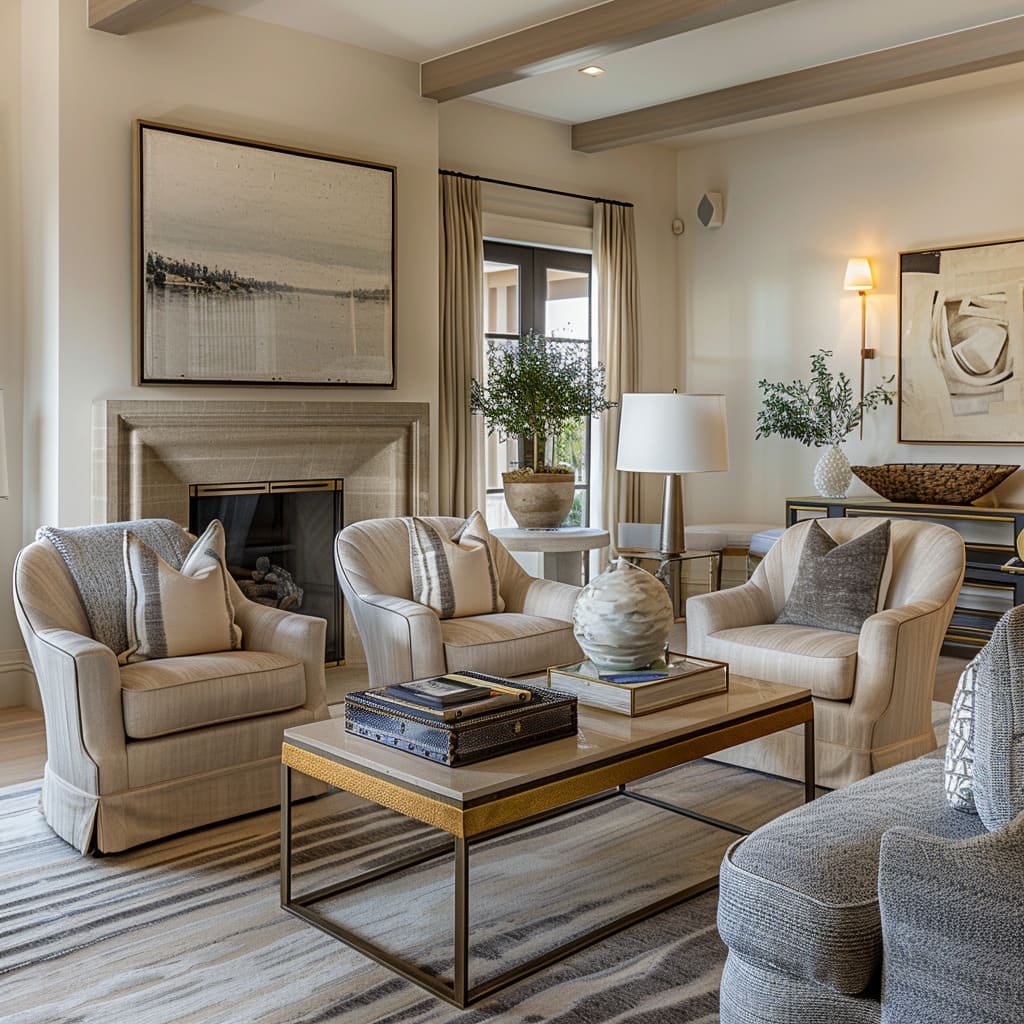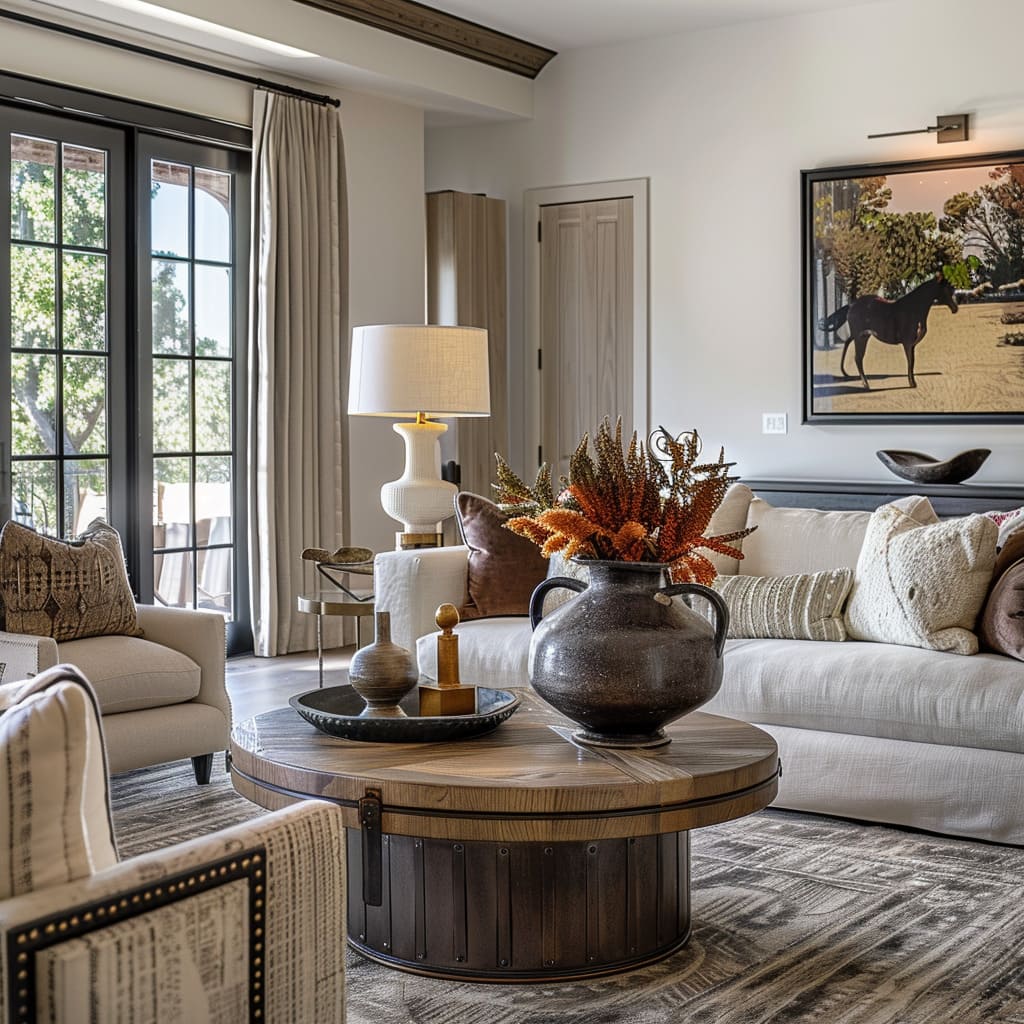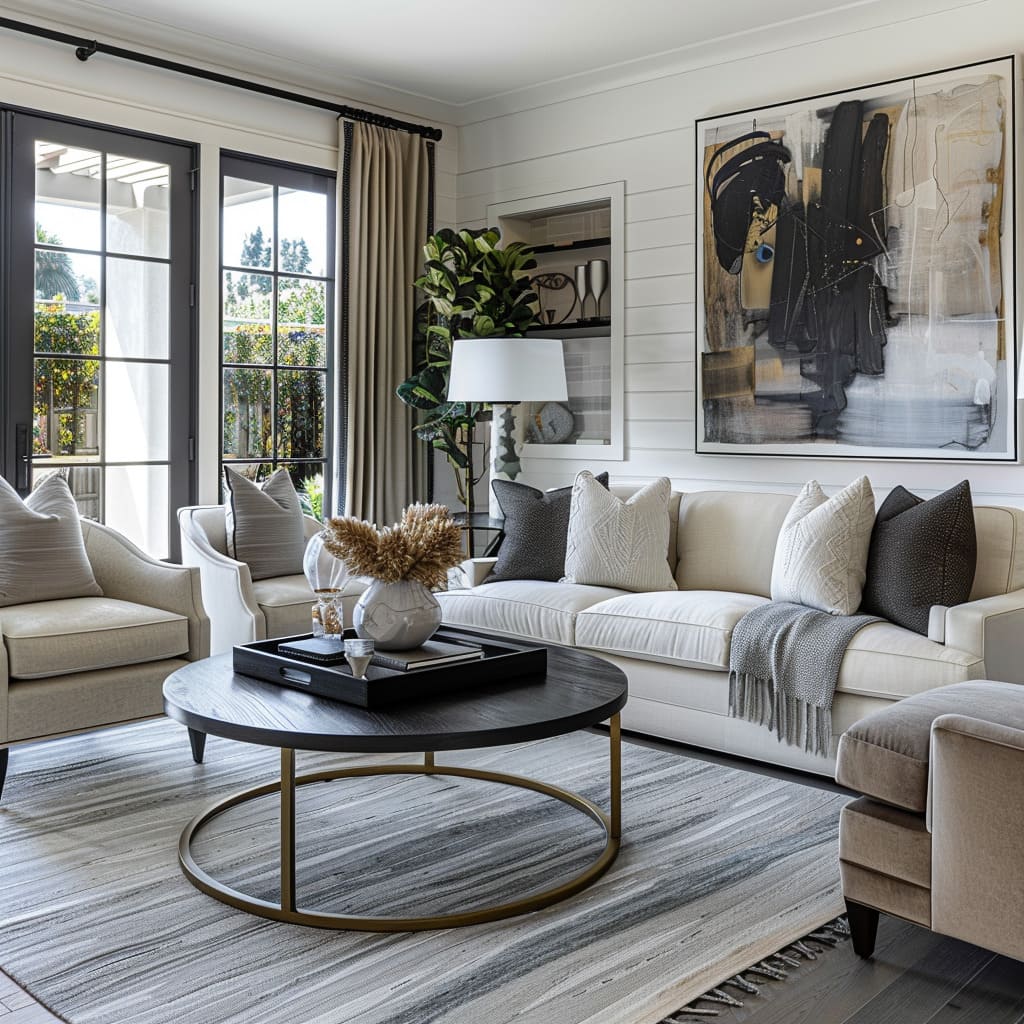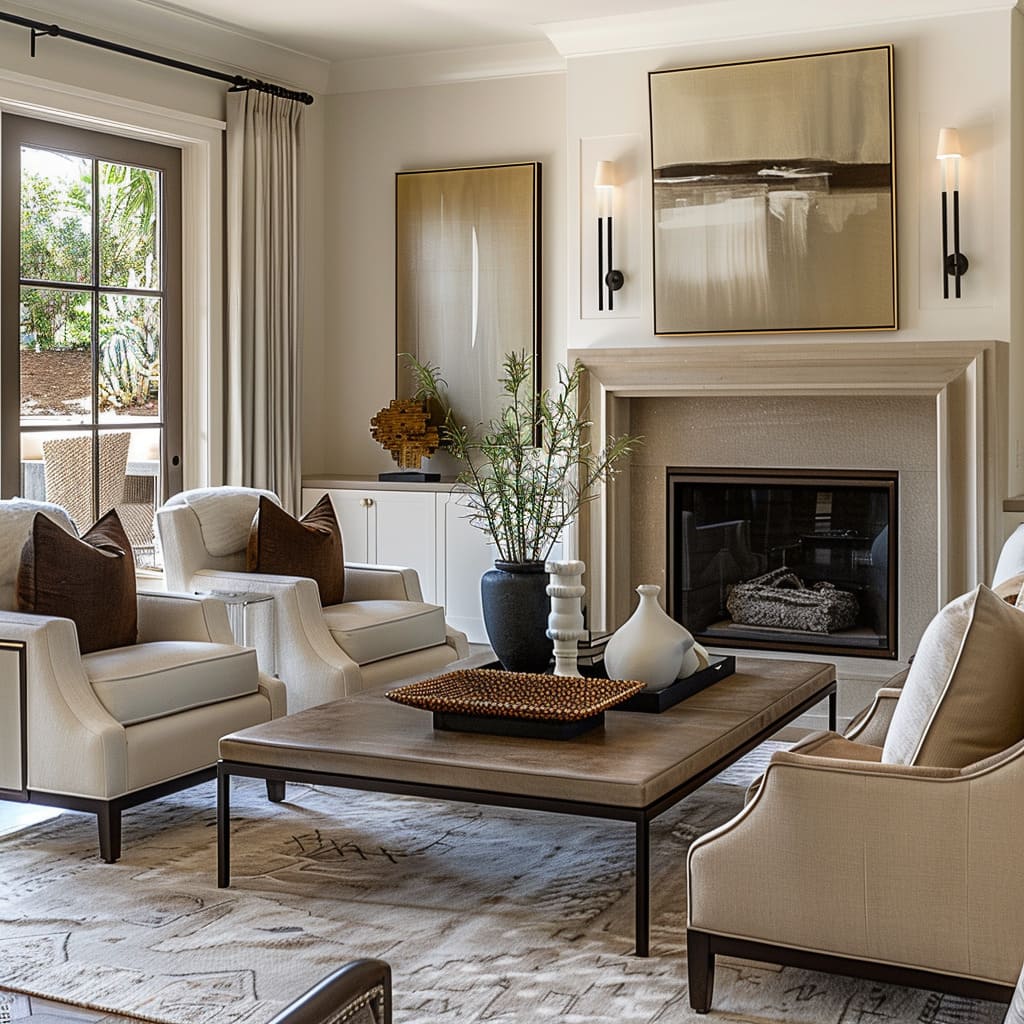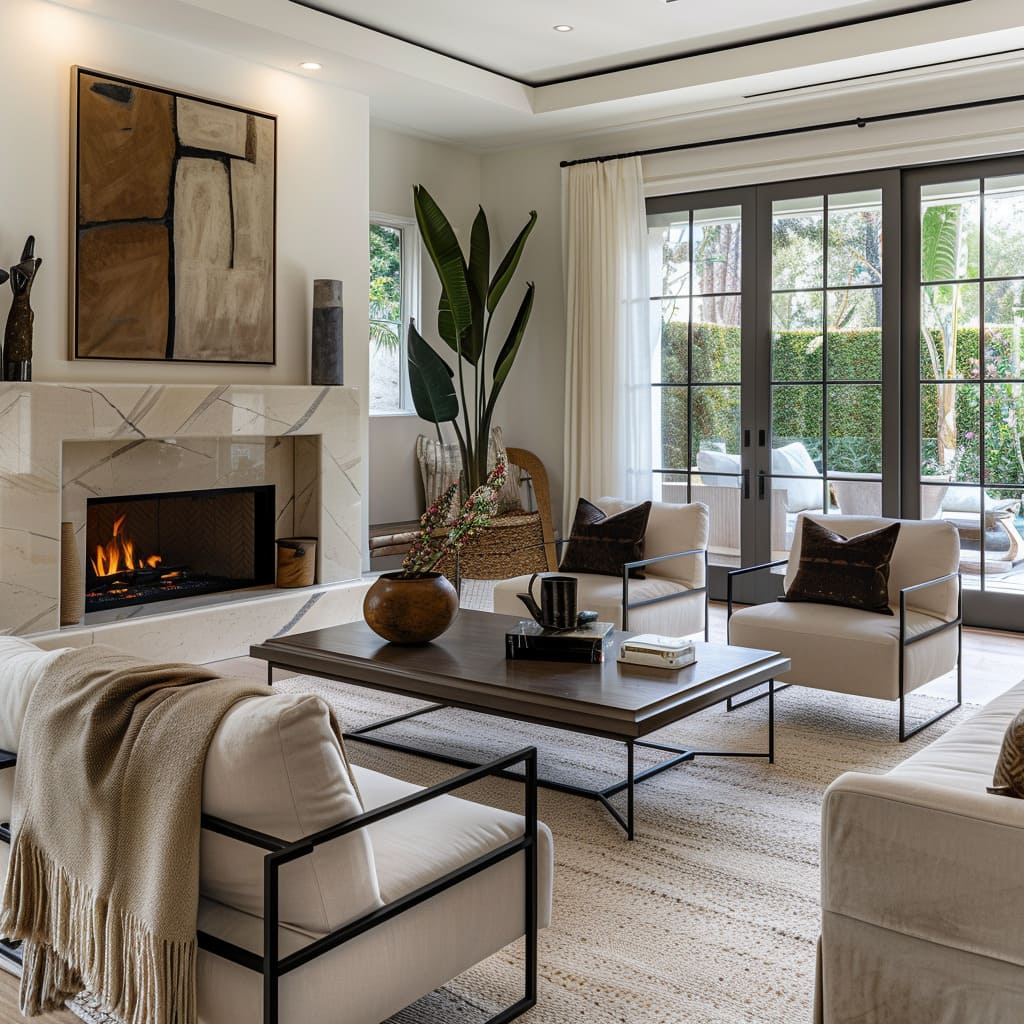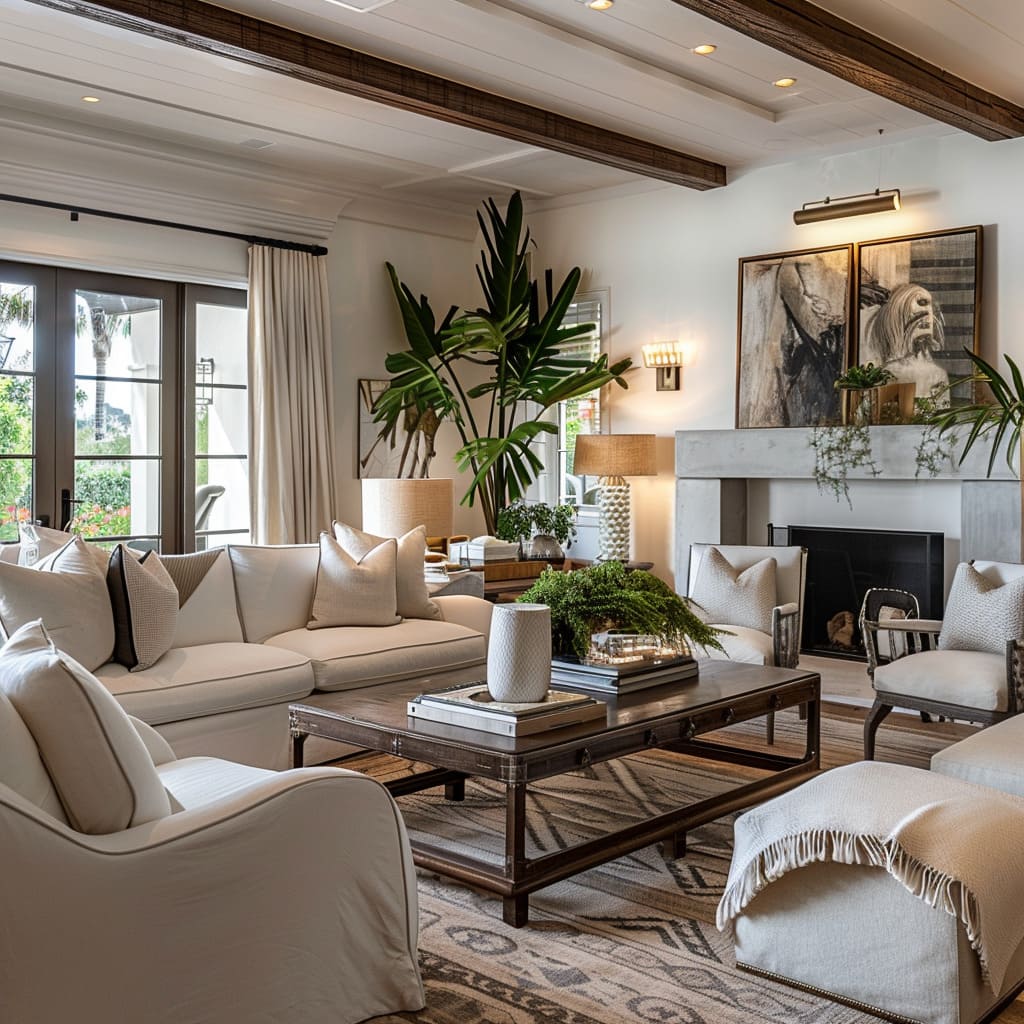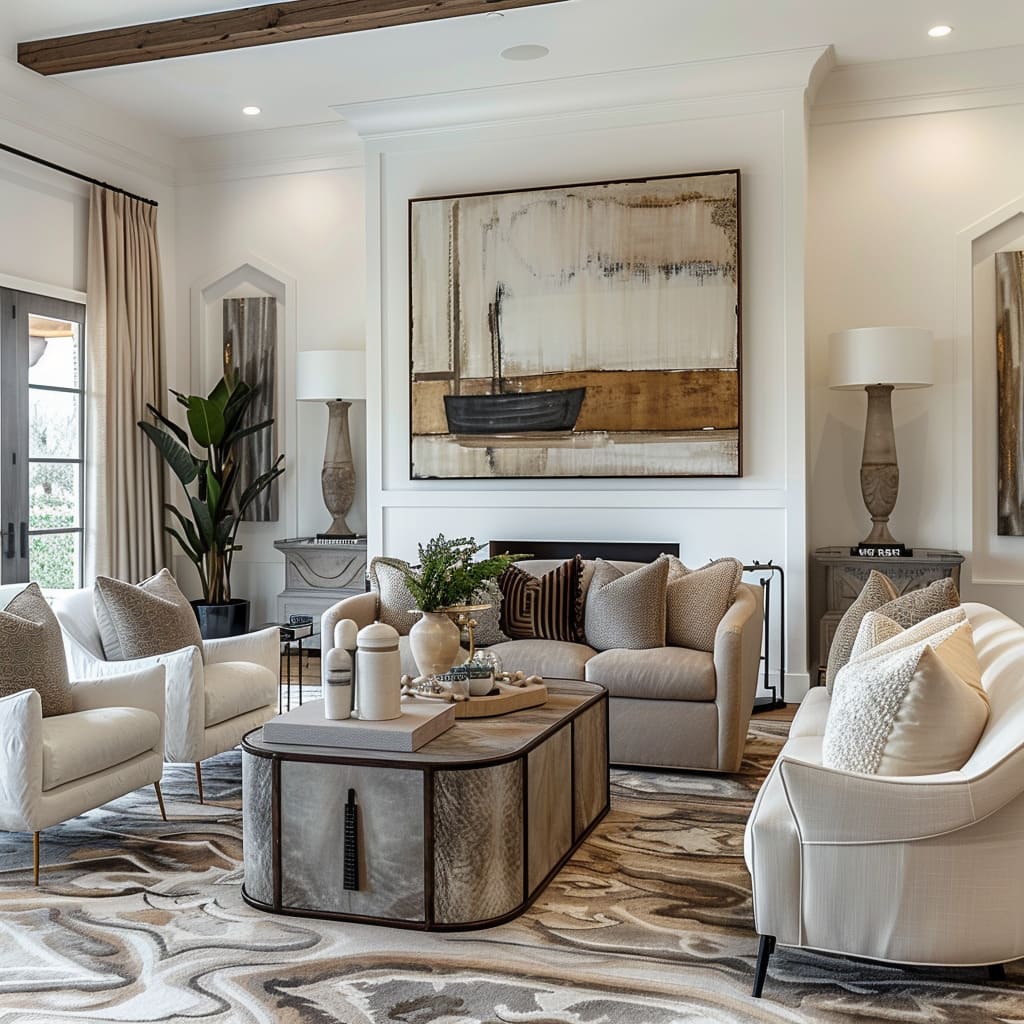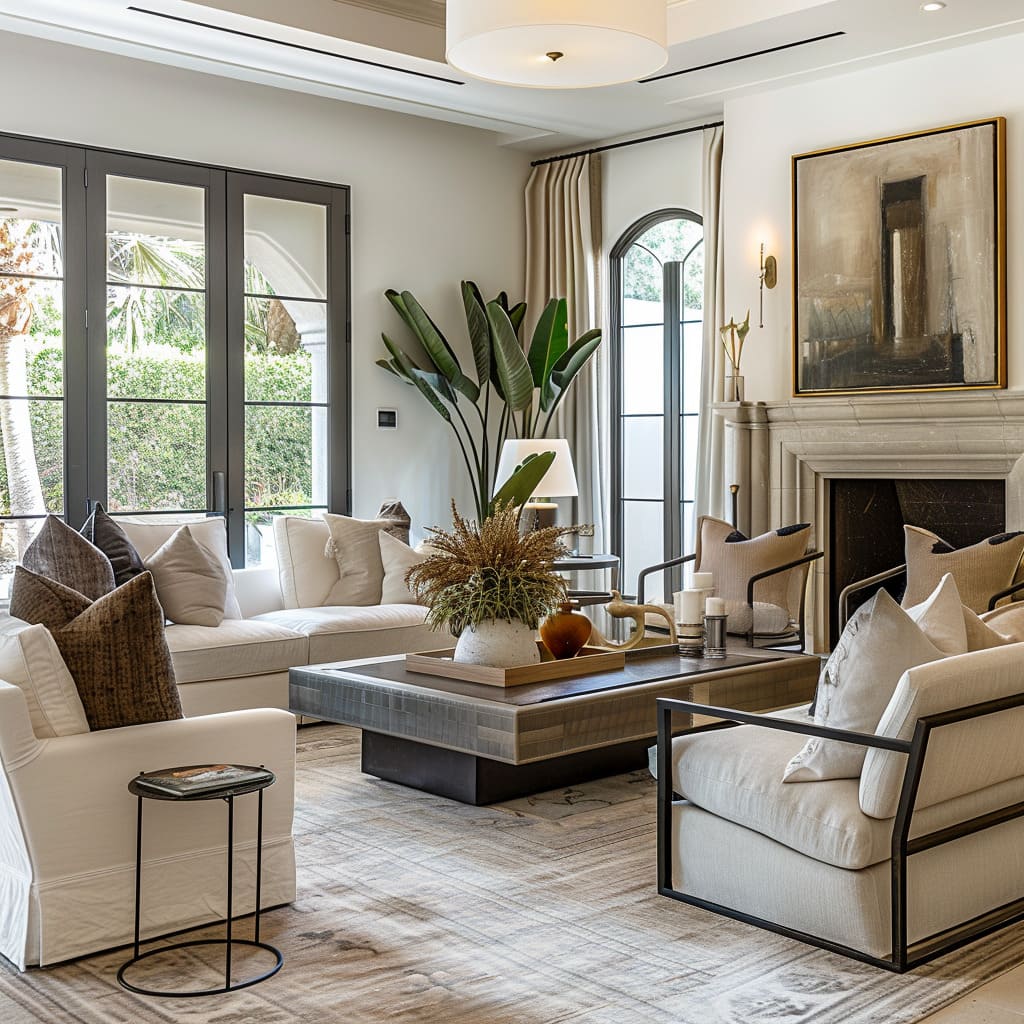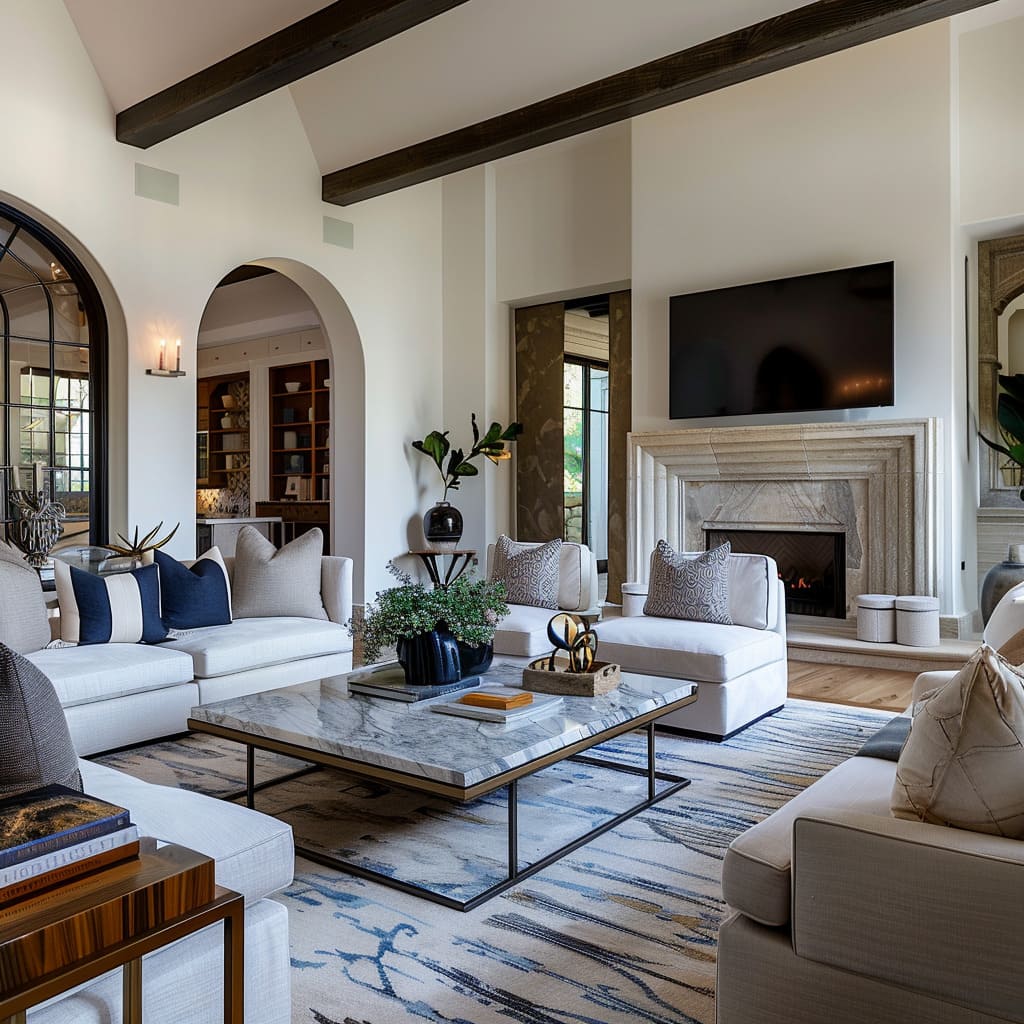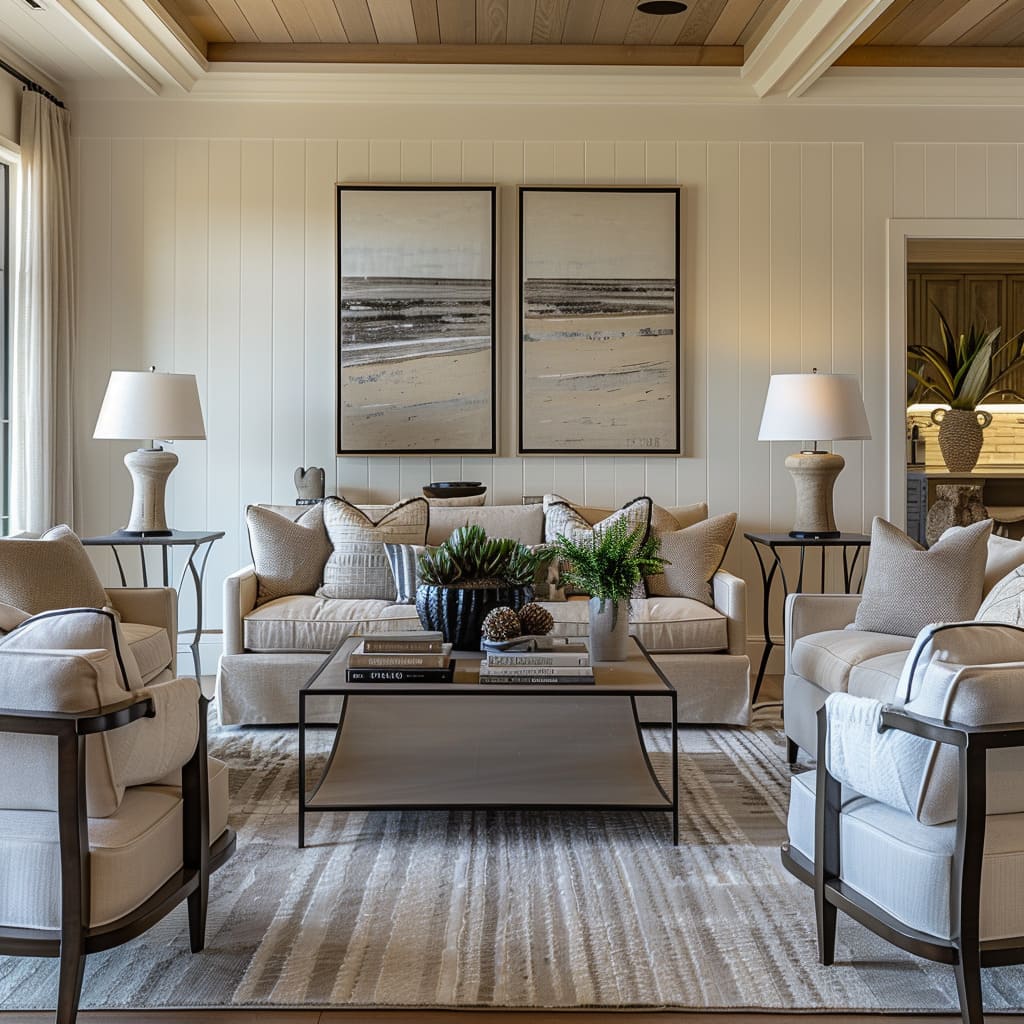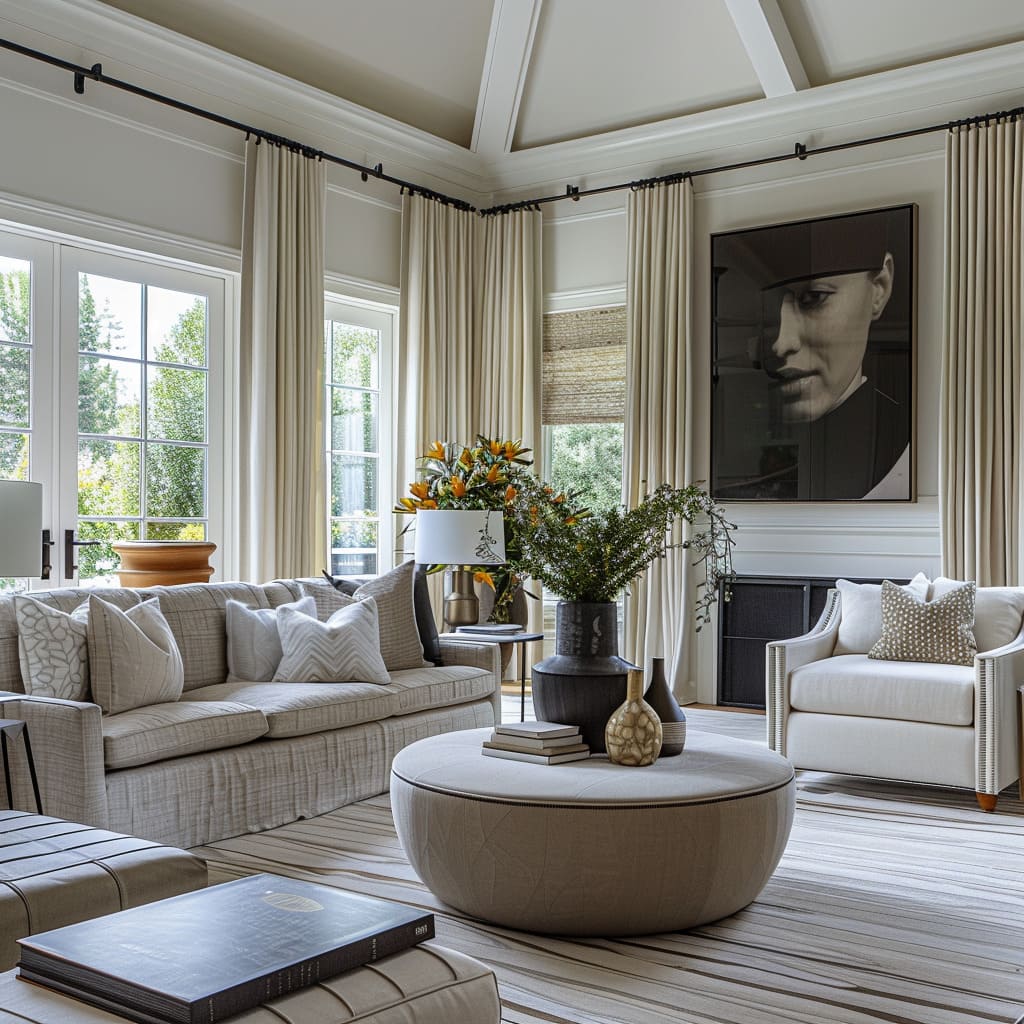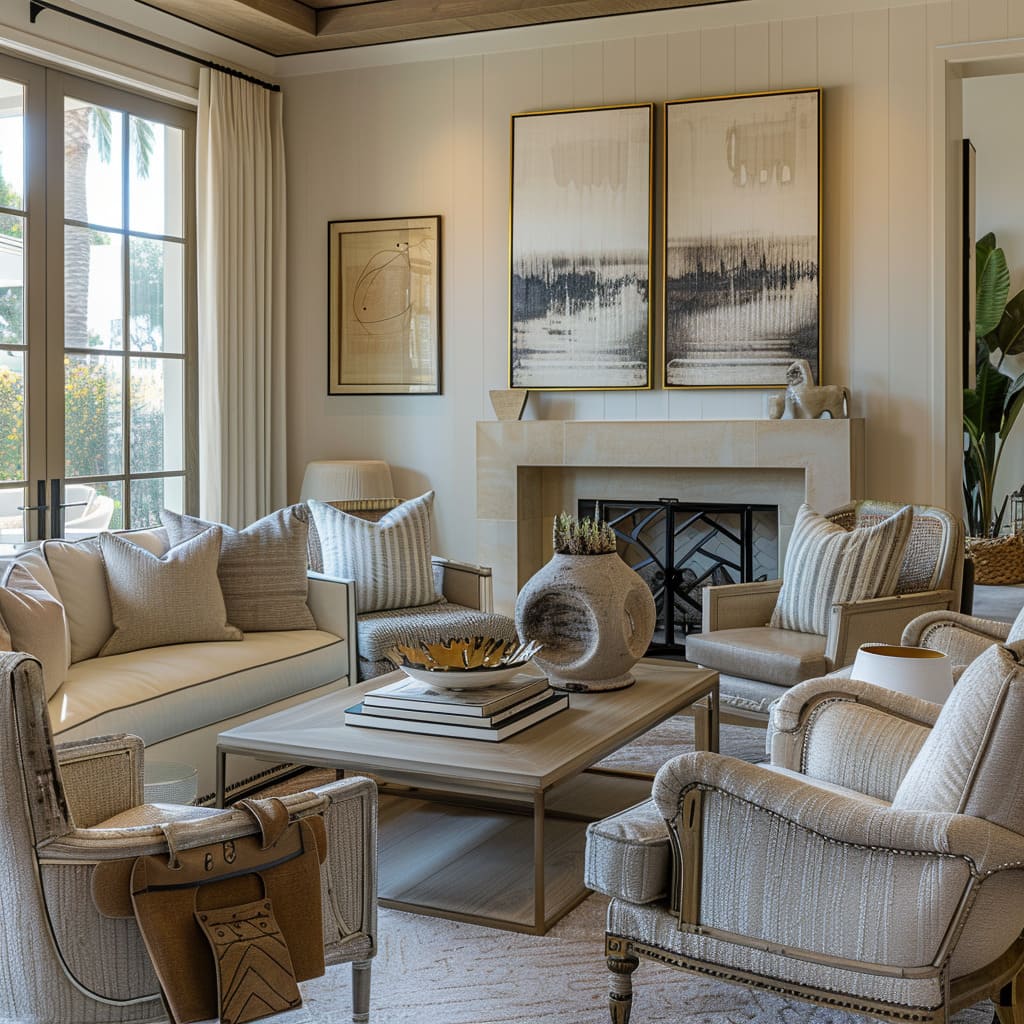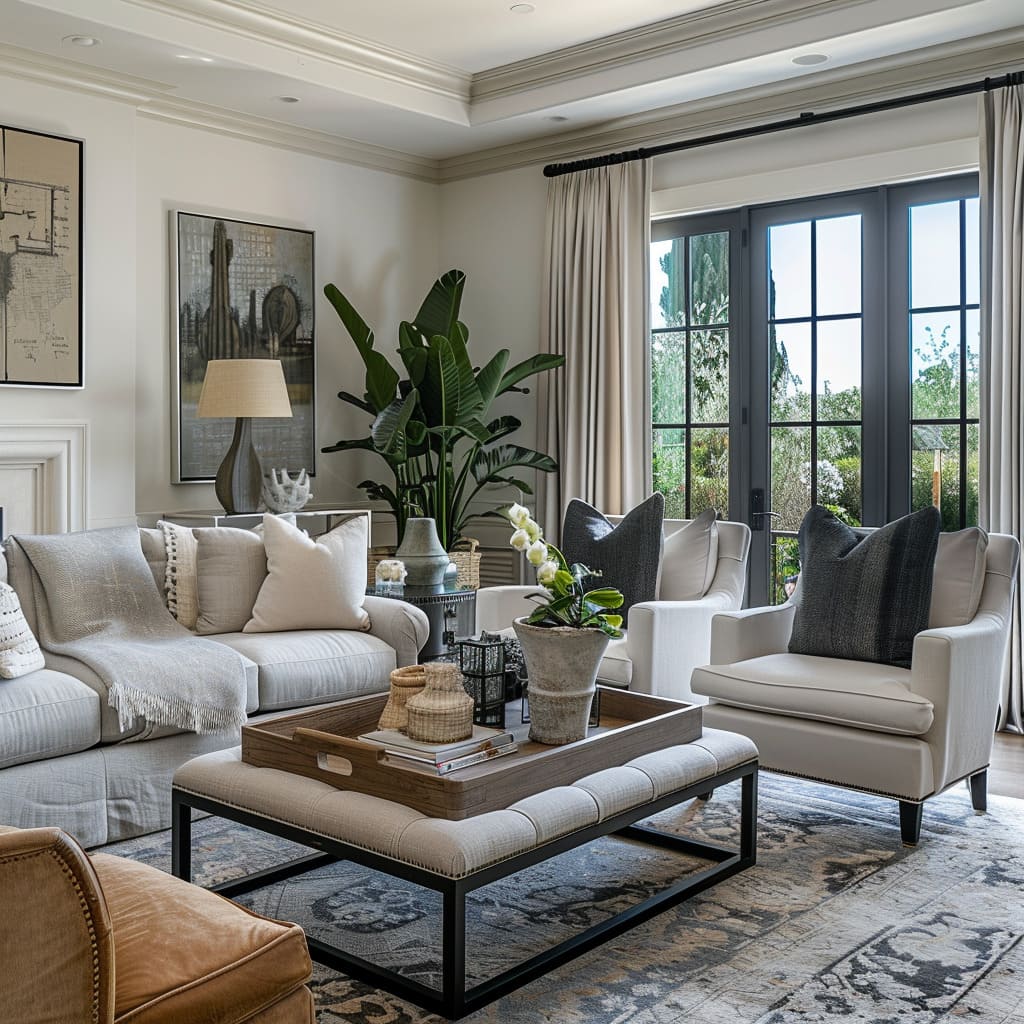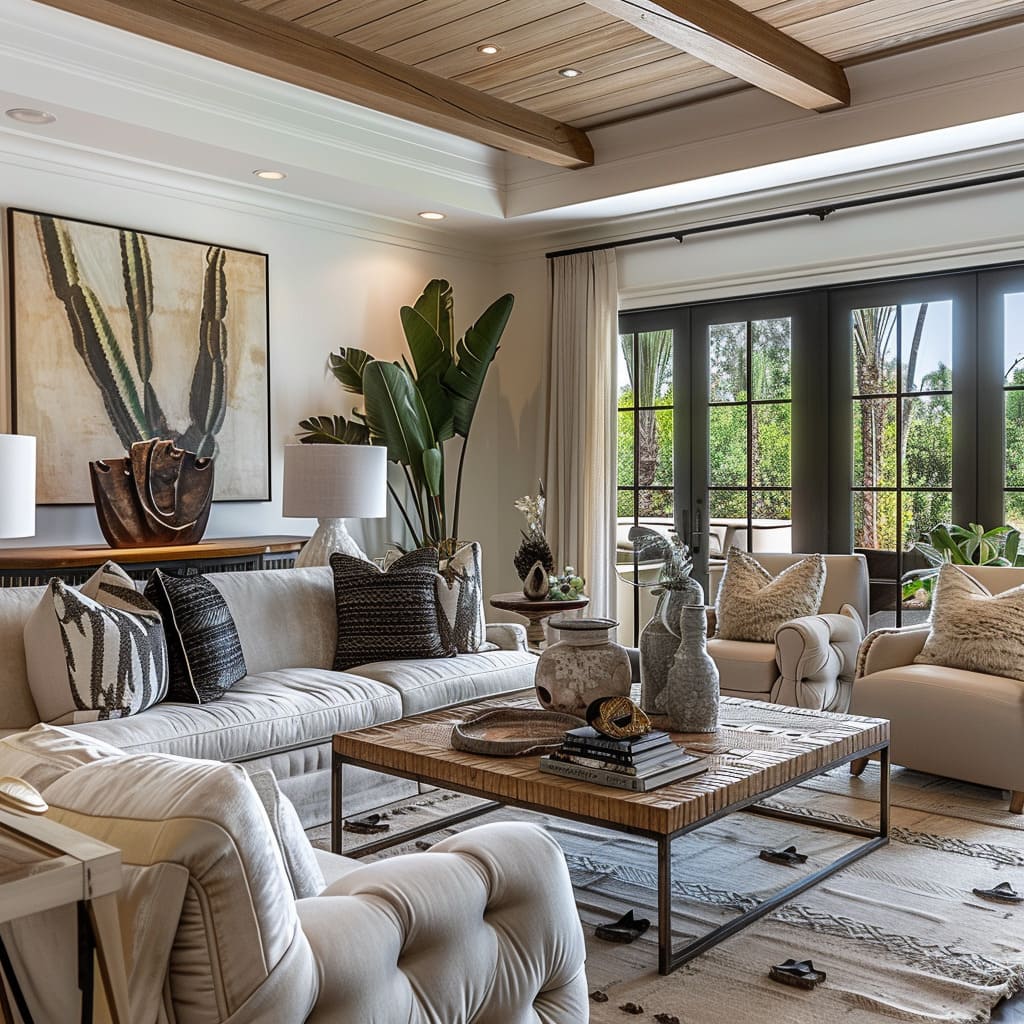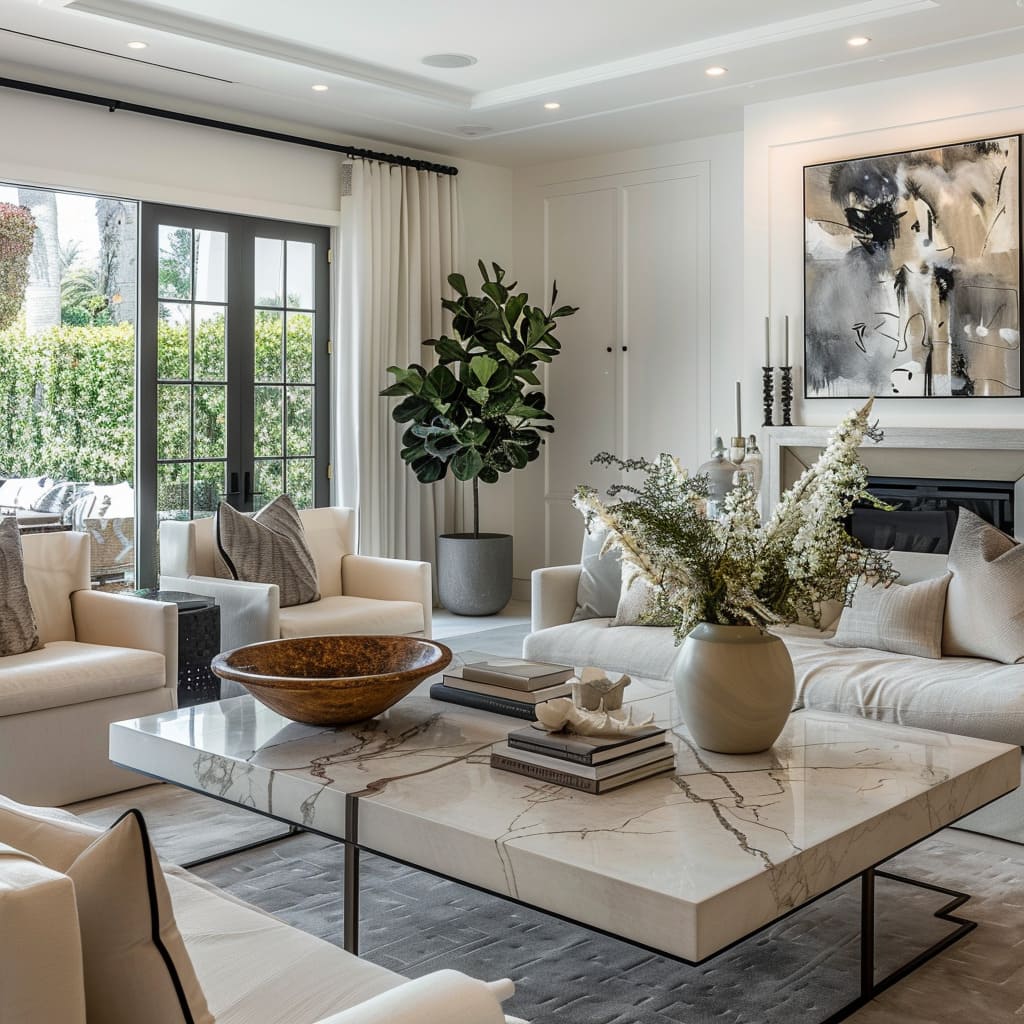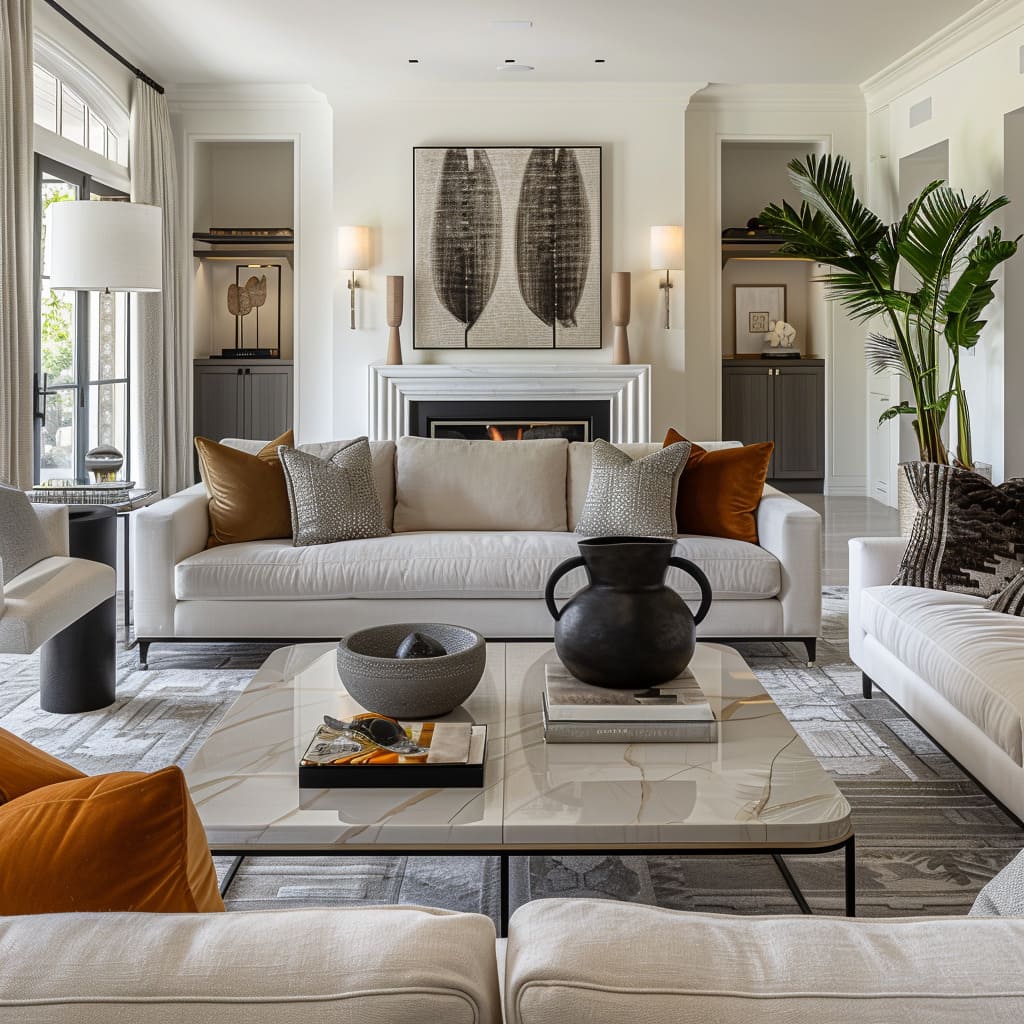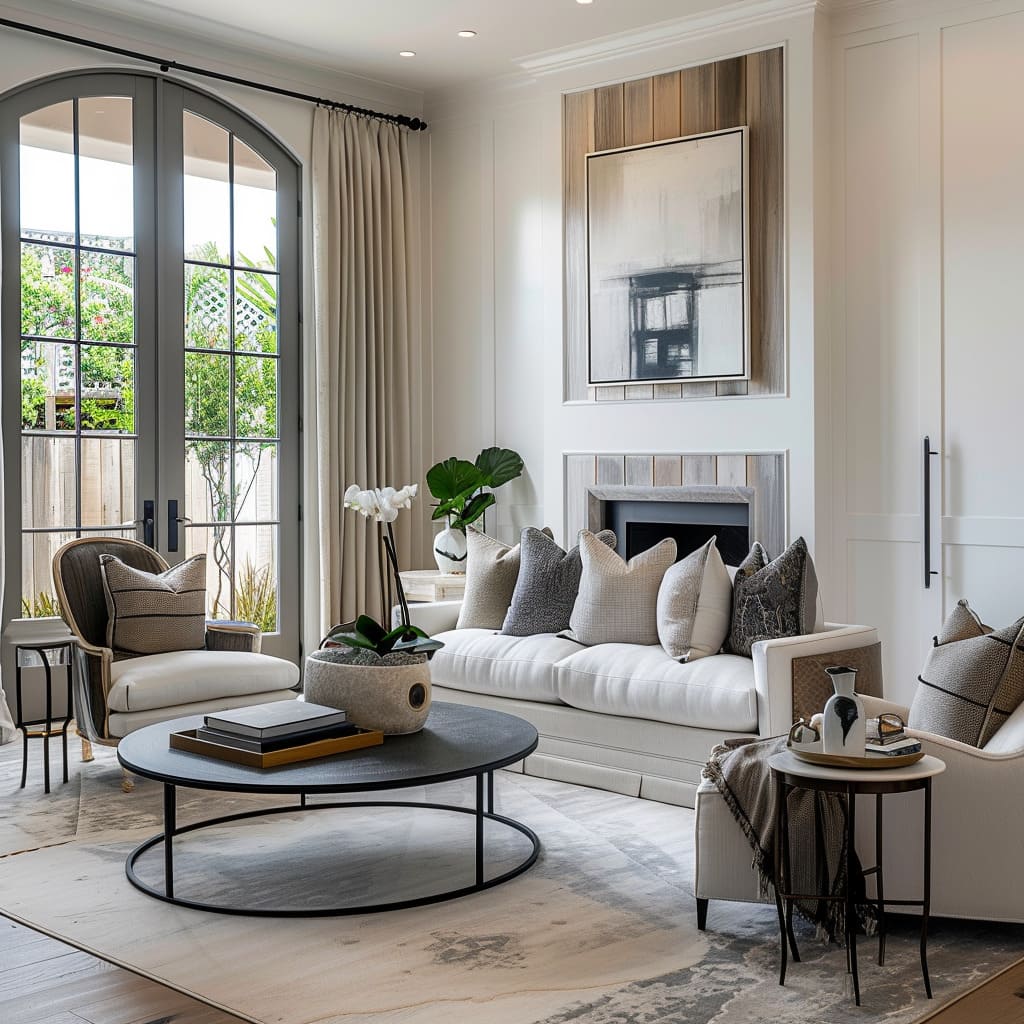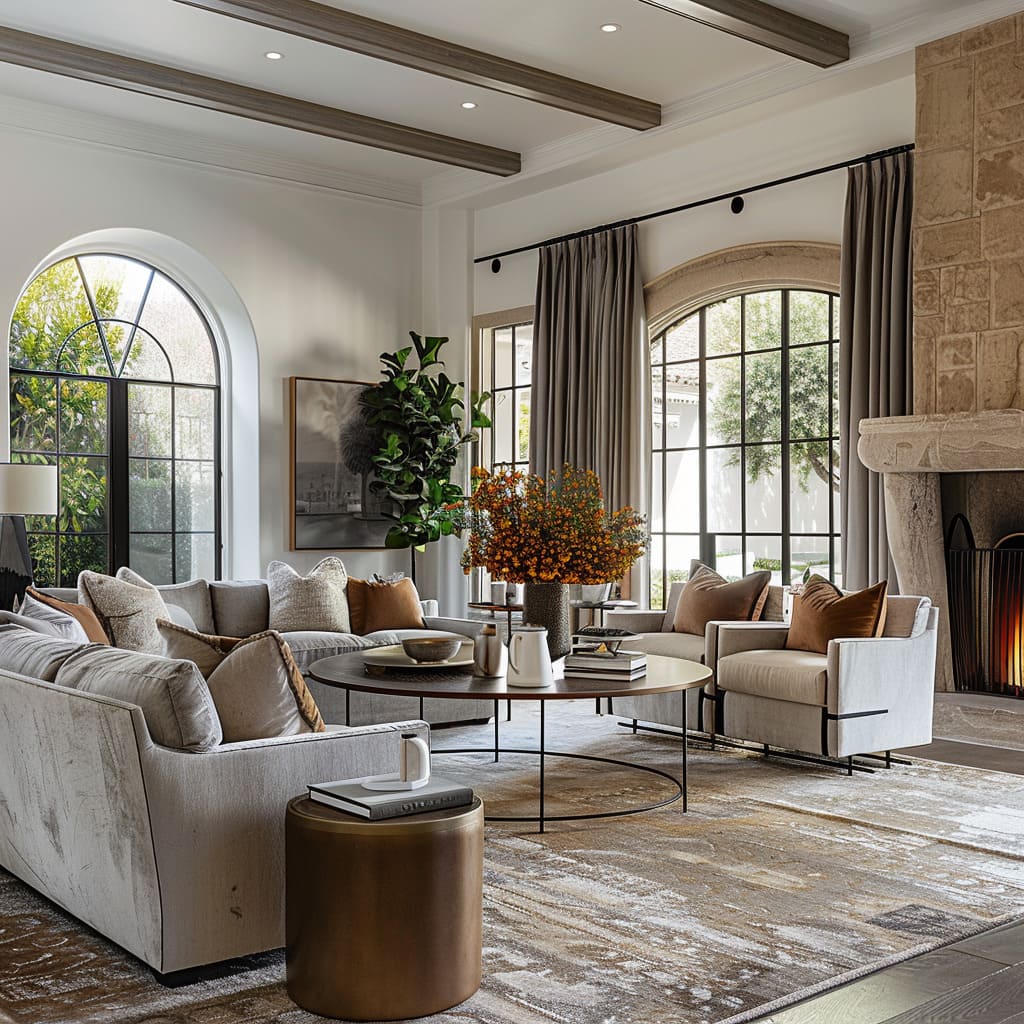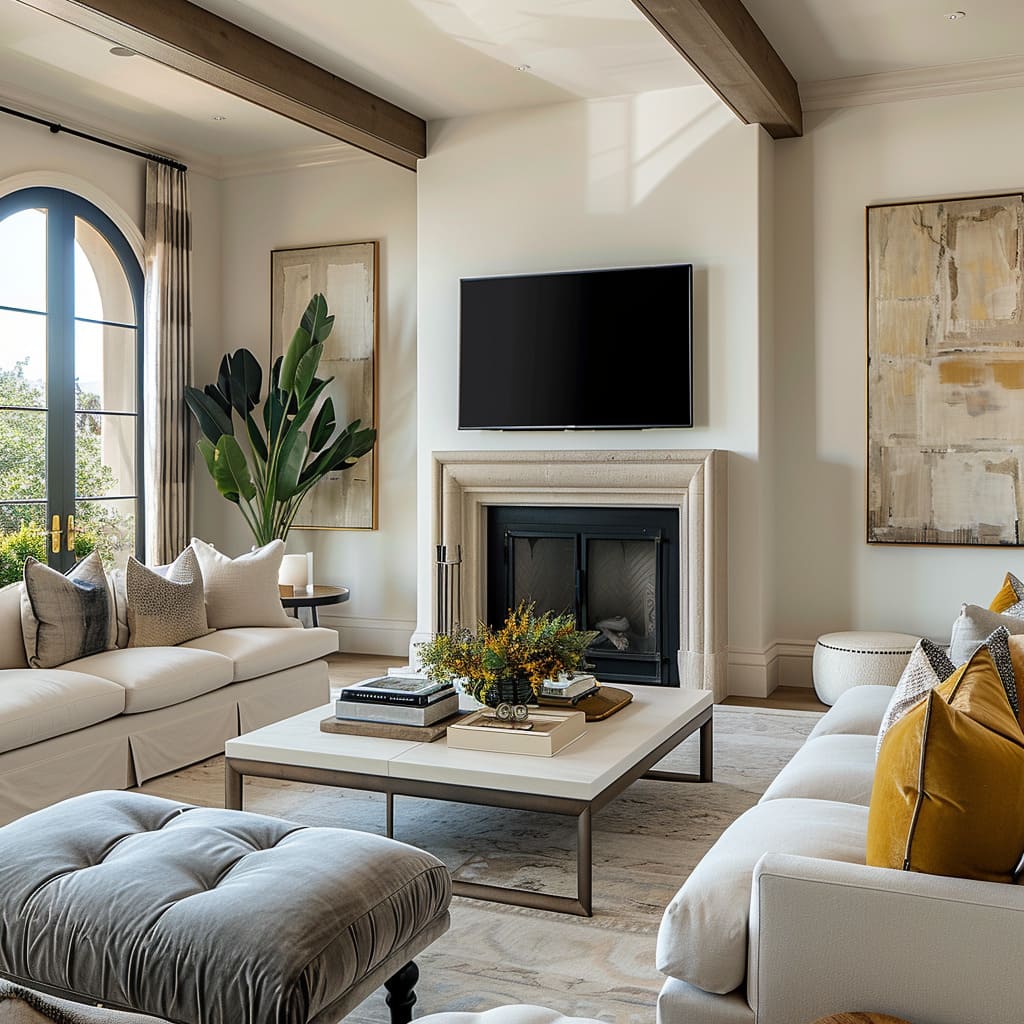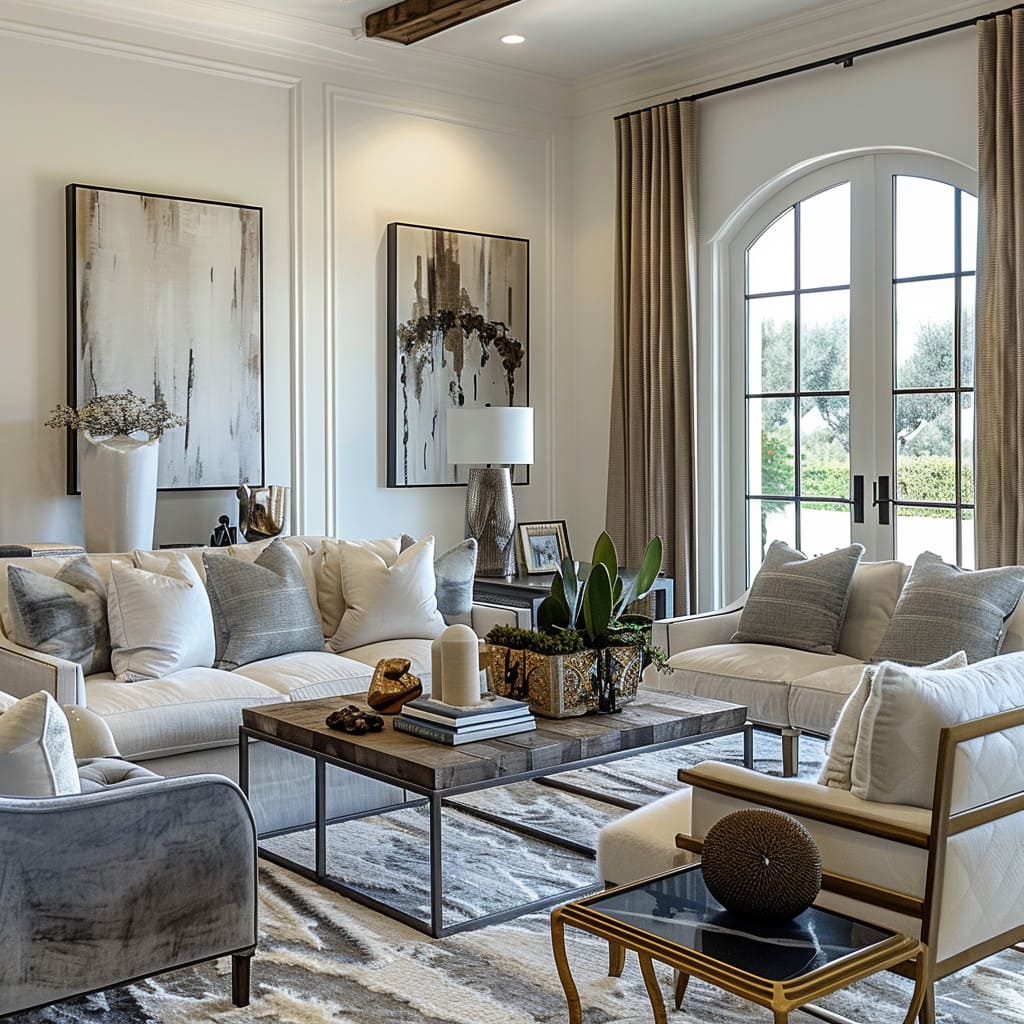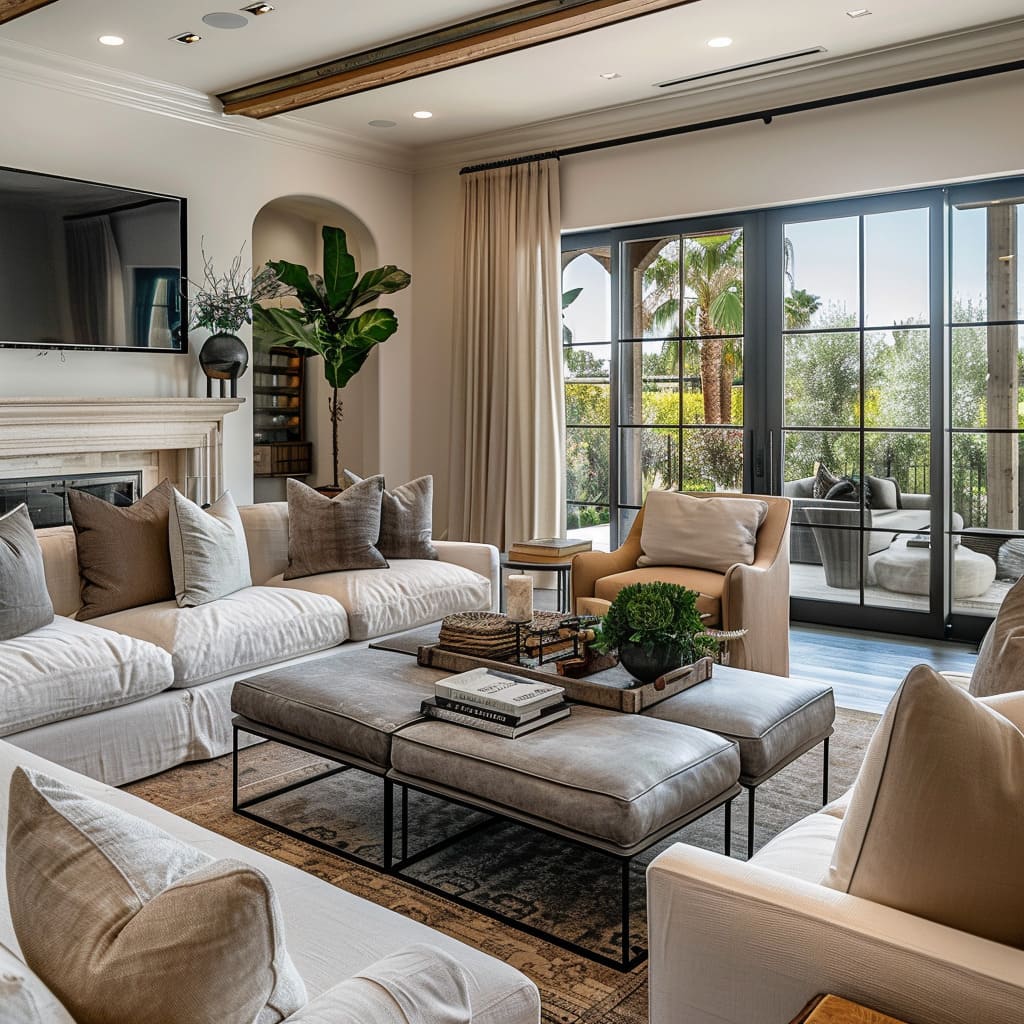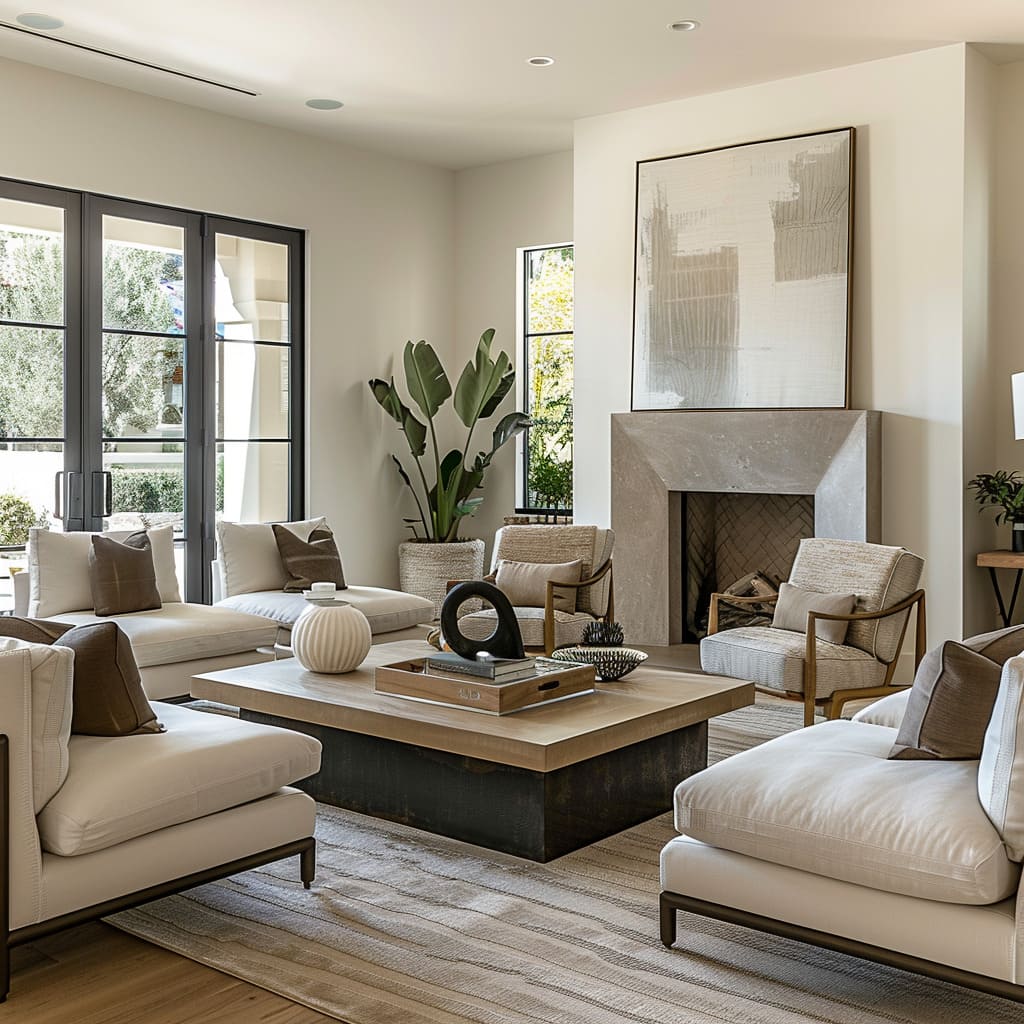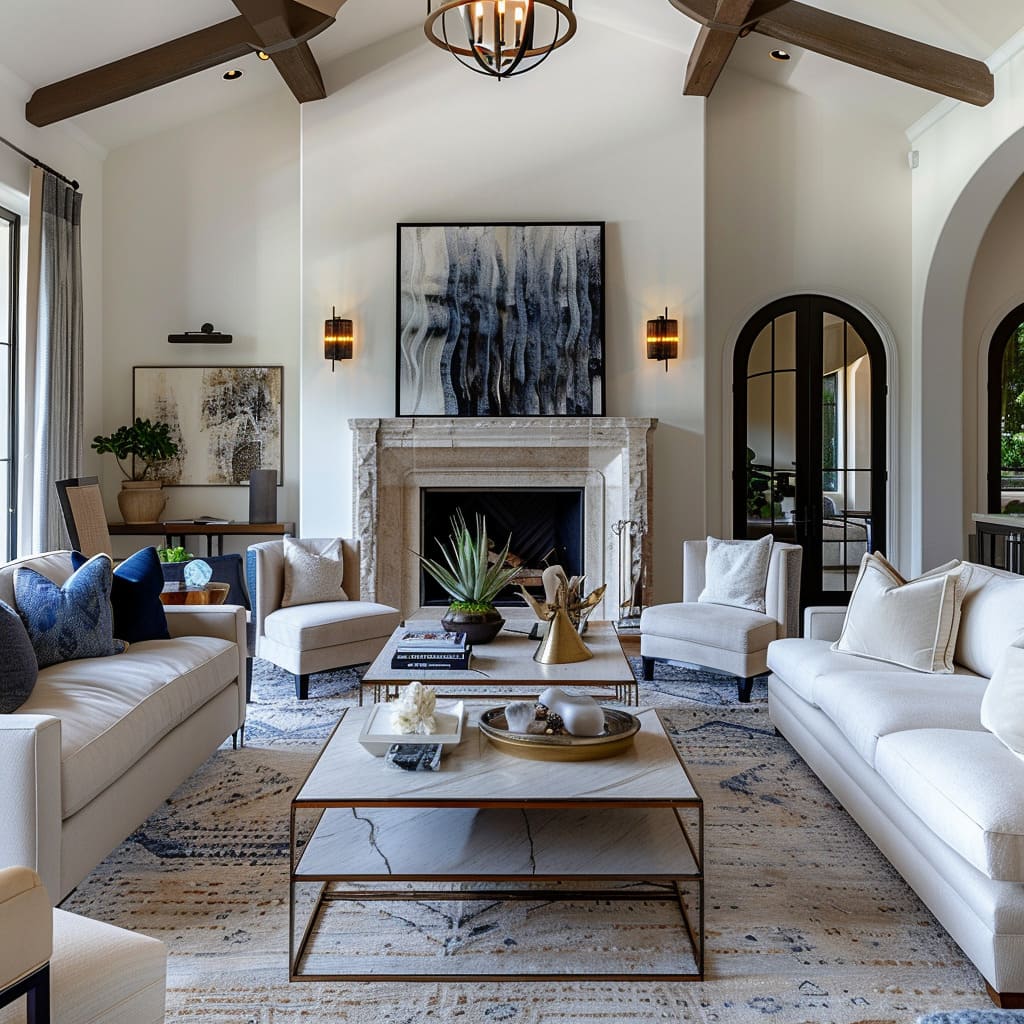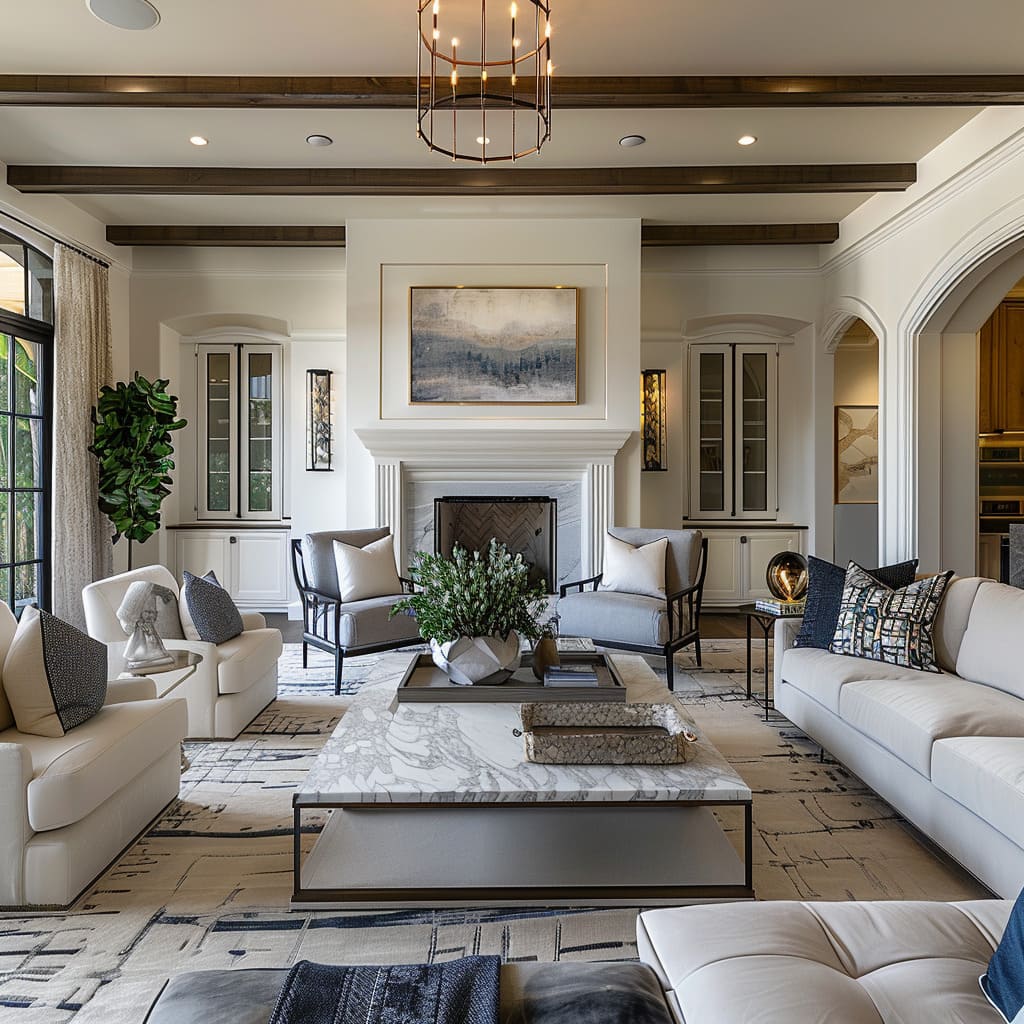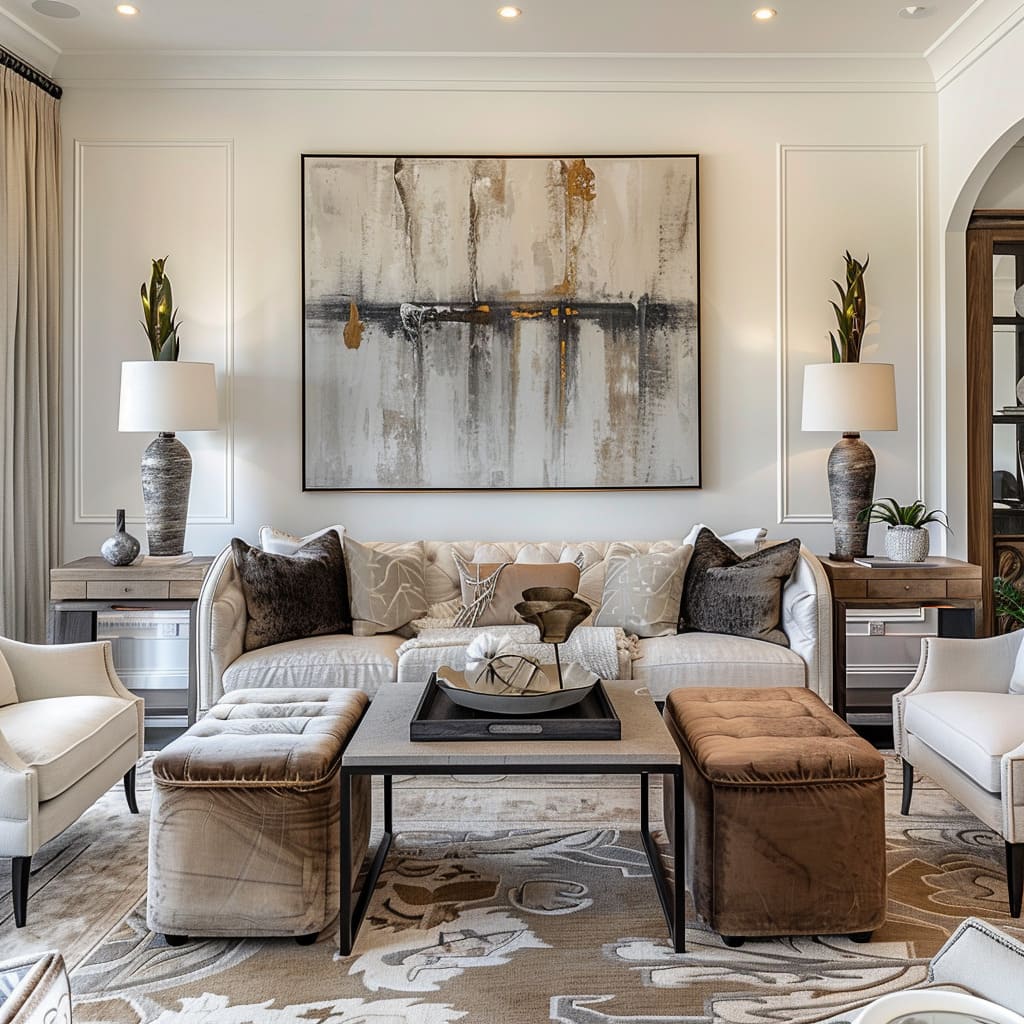Here we talk about interior design, where every detail contributes to the symphony of the living space. This article delves into the nuanced layers of design that go beyond mere aesthetics, exploring how various elements—ranging from the subtle interplay of light and warmth to the sophisticated blending of classic motifs and personal accents—craft environments that are as emotionally resonant as they are visually stunning.
Join us on a journey through the artful integration of textures, colors, and architectural embellishments that transform mere rooms into reflections of personal style and timeless elegance. Discover how the thoughtful consideration of each aspect of design can create spaces that not only showcase individuality but also foster connection, comfort, and inspiration.
Textures and Patterns
The art of interior design extends well beyond visual appeal, delving into the realm of the tactile. Sophisticated textural play is at the heart of this, where the intermingling of fabrics and materials creates a rich tapestry of sensation.
This section explores how textured surfaces, from plush rugs to sleek wood grains, add layers of depth and intrigue to any room.
Sophisticated Textural Play
The juxtaposition of various fabrics and materials creates a tactile experience that adds depth and interest.
Velvet cushions rest against the smooth backdrop of leather armchairs, while woven throws drape over linen sofas, inviting touch and engagement with the space. This interplay of textures is thoughtfully applied, ensuring that each touchpoint offers a unique sensory experience.
Polished Surfaces
Surfaces such as tabletops and mantels have a polished finish that reflects light and contributes to the luxurious feel of the environment. The gleam of a marble coffee table or the sheen of a lacquered console brings a subtle glow to the space, reflecting both natural and artificial light to create an ambiance of understated glamour.
These surfaces serve as smooth counterpoints to the more textured elements within the room.
Intriguing Surface Treatments
Surfaces such as walls and ceilings may feature treatments or materials that draw interest without overwhelming the senses.
A brushed suede wall, a ceiling with delicate stucco work, or a custom wall mural painted in soft washes of color are just a few examples of how surfaces can become a focal point. These treatments enhance the depth and character of the space, offering both visual and tactile variety.
Distinctive Material Pairings
The pairings of materials, such as wood with metal or glass with fabric, are distinctive yet complementary, illustrating a sophisticated material palette. A glass tabletop resting on an aged bronze frame, or a silk throw pillow gracing a raw wood bench, demonstrates the harmony that can be achieved when diverse materials are brought together.
Such pairings not only provide aesthetic pleasure but also speak to a thoughtful and considered approach to design that values contrast and cohesion.
Natural and Organic Elements
The infusion of natural elements into an interior setting imparts a sense of serenity and groundedness. Mature plant selection not only purifies the air but also brings a slice of the outdoors inside, harmoniously bridging the gap between nature and human-made structures.
Here, we delve into the importance of greenery and natural materials in creating a peaceful, organic ambiance.
Mature Plant Selection
Beyond merely ornamental, the plant choices suggest an appreciation for mature, structured greenery that complements the space without overwhelming it. Large leafy specimens, like sculpted ficus or stately palms, anchor the room, adding a living aspect that evolves with the seasons.
These carefully chosen plants resonate with the room’s aesthetic, their natural forms echoing the contours of the furnishings and decorations.
Rugs as Grounding Elements
Rugs are used to define spaces, add warmth, and ground the furniture arrangements, enhancing the overall cohesiveness of the design. The texture and patterns of the rugs are drawn from the natural world, with organic motifs and earthy tones that reinforce the connection to the outdoors.
The rugs’ placement and size are key to zoning the space, subtly delineating areas for different activities while maintaining an open and fluid feel.
Harmony with Nature
The integration of natural elements is achieved in a way that celebrates both the materials’ innate beauty and their environmental symbiosis with the space. Natural light filters through sheer drapery, casting a soft glow that highlights the lushness of the greenery and the warmth of the wood and stone surfaces.
Organic Materials
In addition to plants, other natural materials such as stone, clay, and wool feature prominently. These materials are not only selected for their beauty and durability but also for their natural characteristics, which help to create a space that feels both elegant and earthy.
The strategic placement of these elements encourages a tactile interaction, inviting touch and closer appreciation, and adding to the overall sensory experience of the space.
Design Composition and Layout
In the grand tapestry of interior design, the placement and arrangement of each piece are akin to the careful strokes of an artist’s brush. Curated vignettes, intentional asymmetry, and rhythmic repetition are the components that contribute to a well-composed space, where every item is deliberately placed to create a cohesive narrative.
This section examines how a thoughtful layout can transform individual pieces into a harmonious whole.
Curated Vignettes
Each area within the rooms is thoughtfully arranged, suggesting intentional spaces for conversation, relaxation, or visual enjoyment. Groupings of furniture invite interaction, while accent pieces like unique side tables or statement lighting stand as individual moments of design that draw the eye and encourage closer inspection.
These vignettes are composed not only with functionality in mind but also to create a narrative that speaks to the dweller’s lifestyle and design sensibilities.
Intentional Asymmetry
While balance is maintained, there is an intentional asymmetry in the arrangement of furniture and decor that adds a dynamic quality to the space. This deliberate departure from perfect symmetry introduces visual interest and movement, leading the eye through the room in a way that feels both organic and designed.
It’s a dance of alignment and contrast that makes each space feel alive and personalized.
Focal Point Creation
Each room has a clear focal point, whether it be a piece of art, a furniture arrangement, or a distinctive architectural feature.
These focal points serve as anchors, drawing attention and providing a resting place for the eye amidst the surrounding design elements. The art is chosen not only for its aesthetic value but also for its ability to resonate with the space’s overall mood and theme, reinforcing the design intent.
Careful Composition
Each item in the room is carefully chosen and positioned to contribute to a composed and deliberate look. There’s a conscious decision in the spacing between objects, the height of furniture, and the flow from one area to the next, ensuring that each piece feels as though it belongs.
It’s this meticulous attention to detail that results in a space that is both functional and artistically pleasing.
Rhythmic Repetition
There is a rhythmic repetition in elements such as pillows, chairs, and decorative objects that creates a sense of harmony and order.
This repetition doesn’t just provide visual consistency; it also establishes a rhythm within the space that enhances the sense of tranquility and order. The repetition of shapes, colors, or textures creates a subliminal pattern that ties the room together, contributing to the overall design narrative.
Light and Warmth
Light is the invisible paint that colors our perception of space. This section shines a spotlight on the multifaceted roles of lighting—from the visually impactful light fixtures to the subtle interplay of light and shadow, as well as the ambient warmth that can make a space inviting.
We look at how light is both a practical and poetic element in design.
Ambient Warmth
The use of materials and colors contributes to an overall sense of warmth that invites inhabitants to linger and relax.
Rich wood tones and soft, creamy hues reflect the light, creating an enveloping sense of coziness. Strategically placed lamps cast a glow that softens the edges of a room, while dimmable ceiling lights allow for the ambiance to be fine-tuned to match the mood of any moment.
Visually Impactful Light Fixtures
Light fixtures serve as more than illumination sources; they are chosen for their visual impact and ability to act as sculptural elements within the space. Statement chandeliers and pendant lights act as central art pieces, while sconces and floor lamps add layers of light that enhance the room’s dimensions.
These fixtures are selected not only for their light quality but also for their design, complementing the room’s aesthetics.
Interplay of Light and Shadow
The lighting design creates an interplay of light and shadow that highlights textures and surfaces, adding dimension to the rooms.
This dance of light plays across the fabric of curtains, reflects off polished surfaces, and casts patterns through decorative grilles, contributing to the dynamic visual experience. The careful placement of light sources accentuates architectural details and casts shadows that add mystery and depth to the space.
Focused Illumination
In areas where tasks are performed, such as reading nooks or workspaces, lighting is focused and more intense, providing clarity without harshness. These areas are equipped with lamps that have adjustable intensity and direction, ensuring that functionality is not sacrificed for form.
The choice of bulbs and their temperature is also considered to maintain a consistent color palette that is true to the natural hues of the room and its furnishings.
Natural Light Integration
Windows are dressed in a way that maximizes natural light, using sheer fabrics that filter and diffuse daylight, bathing the space in a soft radiance.
The transition from day to night is seamless as the artificial lighting takes over, maintaining a steady sense of warmth that shifts gently with the time of day.
Color and Contrast
The selective use of color is a testament to the designer’s restraint and understanding of visual impact. Pops of color act as exclamation points in a space, while the overall palette remains a harmonious background symphony.
This section explores the psychology of color and contrast in creating mood and drawing attention.
Selective Use of Color
Strategic pops of color are employed to draw the eye and add vibrancy to the neutral palette, without becoming the focal point.
Cushions, artwork, and decorative blooms often serve as these vibrant interjections, offering a dynamic visual experience. These are carefully selected to ensure they complement rather than compete with the space’s overall tone and texture.
Calculated Color Placement
The placement of these color pops is as crucial as the colors themselves. Whether it’s a single luminescent vase or a series of colorful books on a shelf, these elements are placed where the eye naturally rests or travels.
This strategic placement ensures that each color addition feels like an integral, yet understated part of the overall design.
Psychological Underpinnings
Color is a powerful tool for influencing emotions and behaviors.
The chosen accent colors do more than just beautify; they evoke feelings of excitement, calm, or comfort, depending on their hue and saturation. The design uses these psychological effects to create spaces that can energize or soothe.
Classic Influences and Personalization
The soul of a space is often found in the personal and historical details embedded within. Classic motifs provide a sense of timelessness, while personalized accents ensure the space reflects the individuality of its inhabitants.
This section celebrates the marriage of the old and the new, and the personal stories that make a house a home.
Classic Motifs
Traditional motifs appear in select decor items, suggesting a nod to classic design elements within a contemporary setting. This can be seen in the elegant lines of a Greek key-patterned throw or the intricate carvings on a wooden sideboard, infusing the space with a sense of heritage and sophistication.
These timeless designs act as a counterpoint to more modern pieces, creating a layered effect that transcends any single style period.
Echoes of History
The choice of certain patterns or shapes often harks back to historical periods known for their aesthetic contributions. This could manifest in the form of a Victorian-style tufted ottoman, Art Deco-inspired wallpaper, or Renaissance-reminiscent tapestries.
These elements are carefully integrated to add depth and context to the interiors without overpowering the contemporary feel.
Bespoke Elements
Tailored to the individual’s taste, certain elements within the room are unmistakably bespoke.
Custom-designed furniture that fits perfectly into a unique space or handcrafted trimmings that showcase artisanal skill are just some of the details that make the environment deeply personal.
Personalized Accents
Personalized touches, such as unique collectibles or custom artwork, ensure that the spaces feel lived-in and unique to the inhabitants. These could be objects with sentimental value, such as a family heirloom or a collection of items acquired from travels, each with its own story to tell.
Displayed prominently, they serve as conversation starters and give a glimpse into the lives and passions of the residents.
Transitional Design Elements
In the fluid language of design, transitional elements serve as the connective tissue between diverse stylistic periods. This approach respects tradition while embracing modernity, creating spaces that are neither antiquated nor trendy, but timelessly elegant.
This section delves into the balance and flow that transitional elements provide in interior design.
Use of Transitional Elements
The design seamlessly incorporates transitional elements that bridge the gap between traditional opulence and modern minimalism. Furniture profiles that blend clean lines with classic curves, or lighting fixtures that combine age-old materials like crystal or wrought iron with contemporary shapes, exemplify this blend.
This thoughtful mix of elements encourages a timeless narrative that can evolve and adapt over time.
Fluid Design Vocabulary
The transitional design language speaks with a fluid vocabulary that can encompass a broad spectrum of elements, bringing them together in a way that feels intentional and harmonious. It avoids the rigidity of period-specific design, allowing for a more eclectic and personalized approach that can span the ornate flourishes of the Baroque period to the pared-back simplicity of Scandinavian design.
Adaptive Spaces
Transitional design creates spaces that are inherently adaptive, catering to the evolving tastes and functional needs of its inhabitants. It means that the spaces are equipped to handle the addition of new pieces or the removal of older ones without losing their aesthetic coherence.
This flexibility makes transitional design particularly resilient and long-lasting.
Architectural Embellishments
The bones of a room—its windows, doors, and ceilings—are accented and emphasized through architectural embellishments like substantial molding and trim. These details can elevate a space from ordinary to extraordinary, adding character and a sense of craftsmanship.
In this section, we examine how these features contribute to the overall aesthetic and structural narrative of an interior.
Get inspired by the blend of tradition and modernity in farmhouse-style homes by checking out our featured analysis on exterior design trends.
Substantial Molding and Trim
The use of substantial molding and trim around windows, doors, and ceilings adds architectural interest and a finished quality to the rooms. Crown moldings with intricate profiles crown the junctions where walls meet ceilings, drawing the eye upward and creating a sense of height and grandeur.
Door casings and baseboards with generous proportions and detailed profiles frame the transitions between spaces, anchoring the rooms with a solid, crafted feel.
Architectural Cohesion
The molding and trim work in concert with the room’s architecture to create a cohesive design language. Whether echoing the straight lines of a modern aesthetic or the ornate patterns of a more classical one, these elements unify the space’s theme.
The continuity of design through architectural embellishments lends a seamless flow to the home’s overall narrative.
In conclusion, the journey through the diverse realms of interior design, from the tactile allure of textures and patterns to the historic echoes in architectural embellishments, unveils the intricate layers that constitute truly impactful spaces. Each category we’ve explored offers a unique lens through which we can appreciate the confluence of aesthetics, functionality, and personal expression that defines exceptional interior design.
It is this holistic approach, attentive to the nuances of light, color, form, and history, that cultivates environments not merely to be seen but to be felt and lived in. Ultimately, the art of interior design transcends mere decoration, embodying a dialogue between space and dweller, past and present, form and function, creating settings that not only captivate the eyes but also touch the soul, ensuring that the spaces we inhabit are true reflections of our identities, aspirations, and the times we live in.


